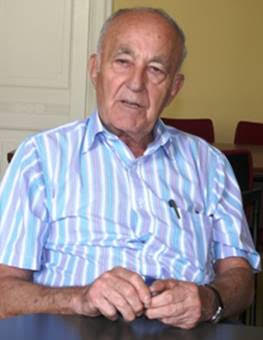
THE VOICE OF INTERNATIONAL LITHUANIA
|
VilNews has its own Google archive! Type a word in the above search box to find any article.
You can also follow us on Facebook. We have two different pages. Click to open and join.
|
The world in Lithuania
- Posted by - (2) Comment
Searching for the Holy Grail?
COME TO VILNIUS!


Forget Rosslyn Chapel in Scotland. Forget the Louvre Museum in Paris. If you're among the millions who have read Dan Brown's book 'The Da Vinci Code', you have probably also made some reflections on how the Holy Grail disappeared, virtually without a trace, after Leonardo da Vinci died in 1519. In that case I will now give you some hints and clues that you can begin to investigate.
Let me first put on the table some facts Dan Brown missed in his book. Brown, and many with him, thinks of Florence, Rome and Paris as the cities da Vinci was linked to. Most people forget that he lived and worked in Milan for many years, and that it was precisely here he painted ‘The Last Supper’ that Dan Brown so strongly emphasizes in his evidence collection.
Brown also does not mention that da Vinci for many years lived in the house of the Sforza family that ruled Milan at that time. But it is in this house the solution to the riddle lies. For it was here 42 year old Leonardo had the pleasure to live when a beautiful baby girl was born in 1494. Bona was the name she was given, and she and 'uncle Leonardo' had a lot of fun together while she grew up. But not just fun. Leonardo had great pleasure in sharing many of his thoughts and ideas with the wise little girl, so when she was a grown young lady of 20 she was quite well informed about many of ‘uncle Leonardo’s’ undertakings, not only in the public sphere but also in the secret. The future Grand Duchess of Lithuanian did, indeed, get a top education...
Deepest of all the secrets Leonardo shared with young Bona, was the story of the Holy Grail and the knowledge of Jesus' marriage to Mary Magdalene. When Leonardo reached his 60s and his health began to fail, he became increasingly concerned over what he should do with the Grail, which by then had been in his possession through two decades. The Milan area had for years been occupied by France, and the North Italian daily life was still strongly marked by war and strife, so Leonardo's concern was not without reason. He had got increasingly concerned that the Grail could come in wrong hands after his death.
It was then that the great idea arose. Leonardo was well aware that Europe's largest and leading nation at the time, the Grand Duchy of Lithuania, was a country built on intelligence and peaceful coexistence between people of many nationalities and cultures, so in 1515, when he found out that the Lithuanian grand duke’s wife was deceased, he was not slow to contact his friends at the Holy Roman Empire to suggest that his young friend, Bona Sforza, should be married to the wise ruler of Lithuania and Poland, Grand Duke Sigismund. His idea was, if the plan succeeded, that he would use this connection for his own special purpose and secretly send the Holy Grail for safe custody in the Grand Duchy under the control of the new Italian-Lithuanian royal family.
Leonardo's plan succeeded beyond all expectation, and already in 1517 Sigismund appeared in Milan to discuss a potential marriage with Bona Sforza. It soon became clear that the arranged marriage was acceptable to all parties, and Leonardo was thereafter not slow to share his idea and concerns with the prospective marriage couple. The idea was that the Grail should be 'camouflaged' as part of a book collection that would be transported to the Grand-Duke's Palace in Vilnius after da Vinci’s death. Sigismund and Bona were married in 1518, and Leonardo died only a year later, in 1519.


Sigismund the Old and Bona Sforza.
The scheme to move the Holy Grail to Vilnius went according to the plan, and the Grail was not long after incorporated as the secret key point in the library that was created in the Royal Palace. The library was based on a large amount of very valid books collected by Leonardo and Bona Sforza, all from the intellectual centres of those days in Italy and other European countries.
The royal couple then ruled successfully for many years over Lithuania and Poland from the palace in Vilnius, proudly aware that they were in possession of Christianity's top secret. When Sigismund died in 1548, widow Bona decided to share the secret with their son, Sigismund Augustus, who had succeeded his father as Grand Duke of Lithuania and King of Poland. After the death of her husband, Bona herself moved to Masovia in east Poland. She stayed there for eight years and then moved to the city of Bari in southern Italy, where since her birth had carried the title ‘Duchess of Bari’
In 1558, a year after settling in Bari, Bona Sforza was poisoned by her trusted officer, Gian Lorenzo Pappacoda. He was acting on behalf of King Philip II of Spain, who wished to avoid repaying his sizable debts to the Grand Duchess. Bona Sforza was buried in a sarcophagus in the Cathedral of Bari. Her sarcophagus stands there, still today, as a sad but strong symbol of the close ties of that time between Italy and Lithuania.

The founder of the Jesuit Order, Ignatius Loyola, sent
his leading theologians to Vilnius immediately after
having been contacted by Sigismund Augustus.
Eleven years after Bona's death, representatives of the Jesuit Religious Brothers came to Lithuania to establish their Order. The Brothers’ first and main task was to plan and build an educational institution of the highest level, and to move the library where the Holy Grail was hidden, from the Royal Palace to a safer place within the new institution, controlled by the Jesuits, Christianity’s leading brotherhood.
The background for this move by the Jesuits, was that Grand Duke Sigismund Augustus after the message of his mother's death reached him, had got into deep worries similar to those of Leonardo da Vinci 50 years earlier: How to best hide and protect the Holy Grail for the future? An important element in his worries was that he was childless, and he had now to face the fact that he could be the last ruler of the world famous Jogailo Dynasty. No wonder he worried that the Grail could get into wrong hands when his reign and life came to its end.
In 1565 he had reached his conclusion; to share his big secret with the Jesuit Brotherhood that had grown to be one of the Roman Catholic Church’s leading movements during the mid 1500s. An open-minded, tolerant monarch and a loyal Roman Catholic, Sigismund had during his reign peacefully sought to counteract Martin Luther’s Reformation in Eastern Europe, and he concluded now that the Jesuits, who successfully preached the Counter Reformation, would be the perfect protectors of the Holy Grail after his death. The Jesuits organised their order along military lines and strongly represented the autocratic zeal of the period, characterised by careful selection, rigorous training, and iron discipline, so Sigismund was convinced they would be the right ones to protect the Grail against the Protestants or any military intruders.
It was with great force that the Brothers came to Vilnius by the end of the 1560s. They had access to large resources both from Vilnius and Rome, and had ahead of their arrival agreed with Sigismund to build an outstanding intellectual and spiritual teaching institution around the Holy Grail. The Grail was thus the beginning of the wonderful Vilnius University, which opened as a Jesuit College in 1570 and as a University in 1579.
Sigismund Augustas was only 50 years old in 1570, but it was already obvious that he didn’t have many years left to live. It was therefore essential to have the Holy Grail moved from the Royal Palace to a safe place where Lithuania's future rulers would not have access. With this in mind, in 1570, Sigismund gave the chapel next to the new college as a gift to the Jesuit Brothers. The Brothers then built, in record time, a bell tower that still today is the highest in Vilnius (at today’s Sts Johns’ Church). The tower was completed already in 1571, and the Holy Grail was immediately moved there from the Royal Palace.
The rush proved to have been by virtue of necessity, for Sigismund died in the summer of 1572. The Grand Duke passed away knowing that the Grail was in safe hands, though he never got to see the University completed. Sigismund Augustus died childless and thus became the last ruler of the grand Jogailo Dynasty as well as of the Italian-Lithuanian dynasty that Leonardo da Vinci and the Holy Roman Empire had planned with so much energy earlier in the century.

The death of Grand Duke Sigismund Augustus in July 1572.
The story of the Holy Grail continued unabated after Sigismund’s death, with frequent communication between the Pope and the head of the Jesuit Brothers in Vilnius. And it was in a direct decree from the Pope that the chapel next to the new bell tower now was expanded to a glorious house of God and given the name Sts. Johns' Church. The name shows that the Catholic Church wanted the highest protection of the new church, the bell tower and, first of all, the Holy Grail. They therefore named and dedicated the new church, not to just one of the St. Johns, but to both John the Baptist and the Apostle John. It was the second time in Christianity’s history that something like this had happened. First time was when the Basilica of St. John Lateran (Basilica di San Giovanni in Laterano), the first among the four major basilicas of Rome was built by Constantine the Great in the 4th century. This church is also the cathedral of the bishop of Rome, the Pope, and is thus known as Omnium urbis et orbis Ecclesiarum Mater et Caput: "Cathedral of Rome and of the World." The Holy Grail gave the Sts. Johns’ Church in Vilnius a similar glorious world value, thus the name.
In 1579, after just nine years of construction, the new university buildings were completed. And it was with great reverence the leading Jesuit Brothers that same year installed the library and within it hiding the Grail that Bona Sforza secretly had brought with her from Milan more than 50 years earlier.
And it is there, under the floor boards of the Vilnius University Library, that the Holy Grail has been safely hidden for 430 years now. The Jesuits have been extremely clever and careful not to share this tremendous secret with anybody. But now, dear readers of VilNews, also you know the truth.
Millions of people visited Louvre and the Rosslyn Chapel after Dan Brown's book was published seven years ago, and I wonder how many are going to visit Vilnius University this year, now that the truth about the Holy Grail is finally made public?
Aage Myhre
Editor

Here, under the floor boards of the Vilnius University Library, is where the Holy Grail was safely hidden
when the university opened in 1579. The Grail is located exactly beneath the centre (the top point) of
the library’s CROSS ARCH, which is typical and characteristic for the Jesuit Order’s Brotherhood.
PS: Please observe that the above article is pure fiction – though based on real historical facts.
- Bookmark :
- Digg
- del.icio.us
- Stumbleupon
- Redit it
- Posted by - (3) Comment

Lithuania has an amazing 700-year history as an international melting pot. This has been especially evident since 1323, the year Grand Duke Gediminas founded Vilnius as Lithuania's capital city and immediately decided to invite merchants, craftsmen, bankers, farmers, and soldiers from all Europe to come to the new capital, guaranteeing all freedom of beliefs and good working conditions. Vilnius became international, though with less of German or Scandinavian influence, as one could expect, rather influenced by Italy and Mediterranean ideas – greatly different from the other two Baltic capitals where Hanseatic influence became dominant.
VilNews will in some upcoming issues publish articles about impacts of foreign nations and cultures here. We also welcome you, dear readers, to share with us information you may have about 'foreign footprints in Lithuania'.
Stephen Báthory, the Hungarian who
became Lithuania’s Grand Duke

Stephen Báthory and his wife Anna Jagiellon were co-rulers, as the second monarch in the Polish-Lithuanian Commonwealth with the dual title ‘King of Poland and Grand Duke of Lithuania’.
You may remember our story about Anna Jagiellon (Lithuanian: Ona Jogailaitė, 1523–1596) daughter of Grand Duke Sigismund the Old and Italian Bona Sforza. In 1572, when the throne of the Polish-Lithuanian Commonwealth, at the time the largest and one of the most populous states in Europe, was vacated after her brother Sigismund Augustus died without heirs, she convinced the Polish and Lithuanian nobles to elect the French prince Henry of Valois as the new ruler. It was Jean Montluc, Bishop of Valence, who had offered the French prince to the electors of the commonwealth as the next King and Grand Duke. Montluc promised the electors that Henry would marry Anna, "to maintain the dynastic tradition". Unfortunately, for Anna, after Henry was elected as the first monarch in the Polish-Lithuanian Commonwealth, he withdrew his promise and they never wed.
In 1574 Henry left Poland to assume his new duties as King of France and by May of 1575 the Parliament of the Commonwealth had removed him as their monarch. By the autumn of 1575 a new candidate was offered to the electors, Stephen Báthory, Prince of Transylvania. Stephen had to agree to the condition that he would marry Anna, which he did.
On 15 December 1575, near Warsaw, Anna along with Stephen Báthory, her fiancé, was elected as co-rulers, as the second monarch in the Polish-Lithuanian Commonwealth with the dual title of King of Poland and Grand Duke of Lithuania. The coronation took place in Krakow 1 May 1576.

Stephen Báthory's Smocze Zęby ("Dragon's Teeth") coat-of-arms.
Stephen Báthory's position was at first extremely difficult, but some important victories in the by then ‘religious wars’ gave him a chance to devote himself to strengthening royal authority, in which he was supported by his chancellor Jan Zamoyski, who was just as skilled a politician. The two managed to win over several factions of the Lithuanian and Polish nobility, mostly by means of better taxation of crown lands and royal property leased to the nobility.
In external relations, Stephen sought peace through strong alliances. Though he remained distrustful of the Habsburgs, he entered into a defensive alliance with Maximilian's successor, Rudolf II, fostered by the papal nuncio. The difficulties with the Ottoman Empire were temporarily adjusted by a truce signed on November 5, 1577.
He ruled the Polish-Lithuanian Commonwealth only for slightly more than a decade but managed to leave prominent trace in the countries’ history. His rule, from 1575 to 1586, was marked by a series of important events such as the Commonwealth victory over Muscovy in the Livonian war and foundation of Vilnius University, both of which had direct repercussions for the Grand Duchy of Lithuania.
With his three carefully planned military campaigns against Russia from 1579 to 1581, Stephen Báthory managed to force Muscovy to denounce its rights to the conquered Livonian territories and sign a peace treaty in 1582. He also established a cannon shop in Vilnius, perfected the artillery and war engineering techniques, reorganized the army and introduced uniforms. Meanwhile, to neutralize a military threat from the south he signed a peace treaty with the Ottoman Empire and the Crimean Khanate.
To bulk up his presence in Livonia Stephen Báthory's in 1579 also deployed the Commonwealth Polish troops. Yet the decisive point in the campaign against Russia was the siege of Pskov that was eventually used by him as a trading chip in his negotiations with Muscovy. The Commonwealth received all Livonian territories that fell under its rule by the Vilnius treaty of 1561, except for the northern Livonian lands under Swedish control. Meanwhile, Russia regained the lands annexed by Poland-Lithuania in 1580. The negotiations were a success. Within three years Stephen Báthory managed to turn the fortunes of the war that seemed to go all wrong for Poland and Lithuania in particular. This was also only a part of the story. The war with Muscovy appears to be only a part of the master plan: Stephen Báthory sought to turn Russia into a dependency of the Commonwealth, use joint forces in a war with the Ottoman Empire and eventually free his homeland Transylvania.
Establishment of Vilnius University in 1579 is another prominent event associated with the rule of Stephen Báthory. While the Grand Duchy was ready to feature its own university already for some time, his decision to found a higher education establishment in Vilnius had clear political undertones. He sought to strengthen the rule of the monarchy in regards to the strong caste of noblemen. To do that he often reverted for help to the Catholic Church, a natural ally against protestant nobles.
The appearance of Vilnius University was in fact a well-planned step in a clever political campaign. It was essential for the Catholic Church to establish an educational establishment before the Reformats would do so. Thus already in 1569, Waleryan Protasewicz, the Bishop of Vilnius, invited Jesuit monks to the city of Vilnius and allocated funds to establish a Jesuit academy. The academy was opened in 1970 with an aim to become a university in the near future. The Jesuits appear to have grand plans for their school in Vilnius that went far and beyond the confines of the Lithuania. The university was to serve as a beacon of Catholicism not only in Grand Duchy but also in the neighbouring states and as far as China.
However the final steps in founding the university appeared to be far from easy. In 1577 Pope Gregory XIII issued a bull that supported the establishment of Vilnius University. Now the Bishop of Vilnius had to secure the support of the Grand Duke. Stephen Báthory granted his privilege in 1578 but that was only a part of the story. For the document to become official it had to bear the stamp of Grand Duchy of Lithuania which was in the possession of Radvila the Brown, the Chancellor of the State and a zealous protestant. The Chancellor did not grant the stamp, so the same procedure was repeated next year. This time King Stephan issued a privilege in Vilnius which was stamped by the minor state stamp of Grand Duchy of Lithuania in possession of the Vice-Chancellor. Once again, he failed to claim the support of Chancellor Radvila the Brown and had the Vice-Chancellor, also a reformist, stamp the document only after threats to take punitive measures. To make the matters complete, on 29 October 1579 the Pope issued another bull that confirmed existence of Academia et Universitas Vilnensis Societatis Iesu. Finally, Vilnius had its own university.
The rule of Stephen Báthory, however brief, undoubtedly left positive marks in the Commonwealth and Grand Duchy history. In a relatively short time he managed to solve imminent external problems of the state and strengthen its internal structures. He acknowledged Grand Duchy of Lithuania as an equal partner in the Commonwealth of two nations and heavily contributed to its further cultural development. According to contemporary panegyrics Stephen Báthory's deeds surpassed previous monarchs and can be compared only to Lithuania’s famous Grand Duke Vytautas.
His death was followed by an interregnum of one year. The Emperor's brother Archduke Maximilian, was elected King but was contested by Anna’s nephew, Swedish Sigismund III Vasa, who defeated Maximilian at the Byczyna and succeeded as ruler of the Commonwealth.
Sigismund III Vasa was King of Poland and Grand Duke of Lithuania from 1587 to 1632, and King of Sweden (where he is known simply as Sigismund) from 1592 until he was deposed in 1599. He was the son of King John III of Sweden and his first wife, Catherine Jagiellon, sister of Anna.
Anna died during her nephew Sigismund's reign, on 9 September 1596. She was the last member of the Jagiellon Dynasty that had started with Grand Duke Gediminas 300 years earlier. With her, Lithuania’s time of glory had come to an end…
Békés Hill in Vilnius

Remains of Bekes Hill at River Vilnia before it was washed away in the 1800s.
This was a hill next to the Hill of Three Crosses in Vilnius, named after Gáspár de Kornyath Bekes (1520 - 1580), a Hungarian noble who was buried on the hill which later became known as the Bekes Hill. His grave was marked by an octagonal tower, 20 meters (66 ft) high and 6 meters (20 ft) in diameter.
The river Vilnia, flowing at the foot of the hill, was eroding it until in 1838 five walls of the monument fell, and other walls went down in 1841. A small cemetery is thought to have been here in the 17-18th century, and at the beginning of the 20th century paths leading from the Botanical and Bernardine Gardens to the hill top were designed.
Bekes was treasurer for John II Sigismund Zápolya, King of Hungary (died 1571). Bekes gained considerable power and favor with the King. In his testament Zápolya, who did not have a legal heir, designated Bekes as Voivode of Transylvania. However, Hungarian nobles did not honour the will and elected Stephen Báthory as their voivode while Bekes was away on a diplomatic mission in the court of Maximilian II, Holy Roman Emperor. Supported by Maximilian, who rivaled Báthory for the throne of the Polish–Lithuanian Commonwealth, Bekes gathered his army and organized a rebellion against Báthory, but was defeated. Bekes lost all of his possessions and was forced to seek asylum with Maximilian in Vienna.
When Poland–Lithuania elected Henry of Valois as its monarch, Maximilian and Báthory ceased hostilities. Bekes unsuccessfully traveled to the Ottoman Empire seeking allies. His hopes were revived again when in 1574 Henry of Valois abdicated the Polish throne and Maximilian–Báthory rivalry resumed. Bekes, supported by Székelys, started another rebellion, but his forces were defeated in the Battle of Sinpaul in 1575. Supporters of Bekes were brutally suppressed and privileges for Székelys were suspended.
Maximilian died in 1576, and Bekes lost any hopes of reclaiming Transylvania. Instead he decided to reconcile with Báthory and became his loyal ally and close adviser despite differences in their religions. During the Danzig rebellion Bekes commanded Hungarian troops, sent to assist Báthory in establishing his control over the Commonwealth, and gained special recognition for his defense of Elbląg (Ebling). During the Livonian War against Ivan IV of Russia Bekes joined the expedition to re-conquer Polatsk (1579).
For his service Báthory assigned him Lanckorona (a village in Poland, near Kraków, today famous for its well preserved 19th century wooden houses) and other lands.
On his way to Hrodna, Poland in 1580, Bekes caught a cold, fell ill, and died later in Hrodna. His body was transported to Vilnius for burial, but none of the city's Christian cemeteries agreed to accept him because of his Arian faith. Therefore he was buried on a hill, which later became known as the Bekes Hill. His grave was marked by an octagonal tower, 20 meters (66 ft) in height and 6 meters (20 ft) in diameter. The hill and his grave were washed away by the Vilnia River in mid 19th century. The former hill territory is now within the Kalnai Park.
Royal stud of horses
in Birštonas

Hungarians started showing interest for the area of Birštonas already in the 16th century, even being rendered the rights of the district for 40 years. In these times a royal stud of Hungarian horses thrived here where River Nemunas makes its amazing loop
Panemunė Castle near Jurbarkas

Over the years 1604 - 1610 the Hungarian nobleman Janusz Eperjes
built the Panemunė Castle right here at the Nemunas River,
not far away from the town Jurbarkas.
Over the years 1604 - 1610 the Hungarian nobleman Janusz Eperjes built the Panemunė Castle on a hilltop at the Nemunas River, not far away from the town Jurbarkas (above today’s highway between Kaunas and Jurbarkas). The castle was probably built in connection with the river driving and transport of timber on the Nemunas River that started flourishing by the middle of the 16th century.
It is supposed that the name of the castle comes from the Panemunė manor, and that Petras Nonhartas, architect for the reconstruction of the Lower Vilnius Castle at that time, was the author of the castle project and the first construction supervisor. He was a friend of the Eperjes’ family.
The Panemunė castle was not built as a defense fortress; it was just a typical feudal castle with defensive equipment typical for the 17th century. The original castle was built in Renaissance style, with some Late Gothic elements. It is today considered one of the most beautiful Renaissance Epoch buildings in Lithuania. The castle was surrounded by five ponds with four water mills and some farm buildings, remaining from the old manor. A wonderful castle park with five cascade pools and a hilly relief leaves also today’s visitors with an unforgettable impression.
By the middle of the 17th century Janusz Eperjes son Christopher reconstructed the castle, introducing several baroque elements. . At the end of the 18th century the castle was reconstructed in classical style, and some of the old buildings demolished.
In 1925 the Lithuanian government made the castle a national possession and in 1935 the Panemunė Castle and its surroundings were taken under responsibility of the Lithuanian Ministry of Culture. In 1961 it was included into the list of national culturally valuable monuments. In 1995 – 1997 the castle was partially reconstructed.
Nowadays Panemunė Castle has two remaining corpuses – the western wing that includes two towers – and a southern wing. Panemunė Castle belongs to the Vilnius Art Academy, responsible for restoration and maintenance, as well as fitting it to science, education and tourism purposes. During the summer season the Vilnius Art Academy arranges expositions of art here.
Visitors are also let to climb up the towers and watch the spectacular view of the Nemunas River and the landscapes around. The nearby park is a part of the whole structure of the castle. It is a perfect example of a landscaped park that strengthens the overall impression of the Panemunė Castle on its beautiful hilltop location.

- Bookmark :
- Digg
- del.icio.us
- Stumbleupon
- Redit it
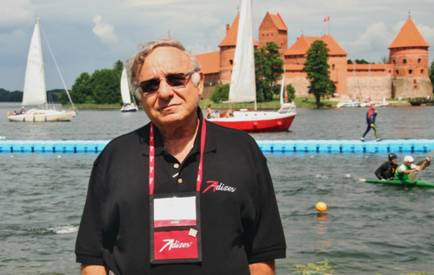
“I am an organisational healer, providing and working with change management for companies, organisations and governments. But not all listen to my advices,” said Dr. Ichak Adizes when we sat down at a lunch table in Trakai Saturday, using the former Serb leader Milosevic and the Greek Government as examples of exactly that.
The annual ‘Adizes International Convention’ took place in Vilnius this weekend. It was the 33rd annual convention for the global organisation that Dr. Adizes started three decades ago. And on Saturday all the convention delegates from around the world were bussed to Trakai for an ‘almost self-baked lunch’, a visit to the castle; plus a little glimpse into the past of the Karaim people who came to Trakai from Crimea 600 years ago, still today representing a huge surprise to most visitors meeting these colourful, Turkic people in far north Lithuania.
My conversation with Dr. Adizes this Saturday afternoon was rather brief and superficial. There were simply too many people and too much noise around us. I will therefore leave it up to his own articles/blogs (below) to speak for him this time.
We did, however, get the opportunity to touch several aspects of what he has experienced during his long life as a consultant and advisor for businesses, organizations and governments around the world. His story about his talks with Milosevic in 1991 follows below.
The fact that his advice to the Greek government, about 20 years ago, regarding the country's way to plan their finances, were not listened to or followed, is a topic we will try to return to at a later date. Just sad to see how much it now costs the country to have been bad listeners when it still was plenty of time to choose another course...
Maybe it’s time now for Lithuania to seek professional advice?
Aage Myhre, Editor-in-Chief
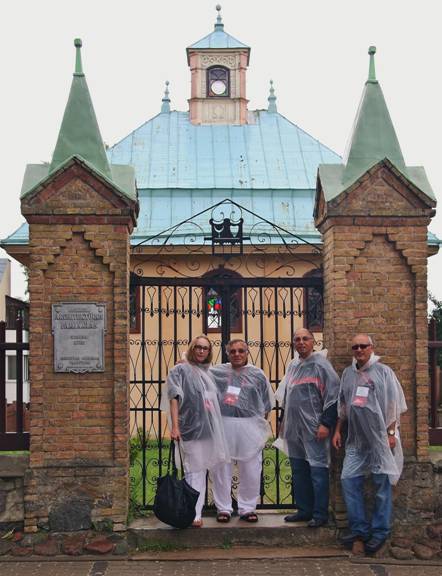
Nurit and Ichak Adizes, Shimon M. Rojany and Gad Mizrahi from the global Adezis organisation were all deeply impressed by the story about the Trakai Karaims. Here in front of the Karaim temple in Trakai, the ‘Kenasa’.
Dr. Ichak Adezis
Dr, Ichak Adizes was born in Skopje, Macedonia, the 22nd of October 1937. In 1948, his family moved to Israel, where he completed his undergraduate studies. In addition to attending college, he also applied for the army.
Dr. Adizes has a Ph.D. and M.B.A. from Columbia University and a B.A. from Hebrew University. He works in English, Spanish, Hebrew, Serbian, Croatian, Bosnian and Macedonian languages.
His works are carried out through the Adizes Institute, a consulting company he founded with offices in 15 countries. The Adizes programme for leading organizations to prime performance, has been used successfully by over 1,000 organizations worldwide, ranging in size from Fortune 100's and non-profits to start-ups and mid-sized companies. As an advisor to foreign governments, Dr. Adizes has consulted with the Prime Ministers and cabinets of Israel, Sweden, Greece, Brazil, Ghana, Iceland, Mexico, Macedonia and others.
Dr. Adizes' work has been featured in Inc. Magazine, Fortune, The New York Times, London Financial Times, Investor Relations Daily, Nation's Business, World Digest and others. He is the author of 13 books that have been published in more than 50 editions and 26 languages. His Corporate Lifecycles: How Organizations Grow and Die and What to Do About It is regarded as a classic in management theory. Executive Excellence, one of the most prestigious business magazines in the United States, ranked Dr. Adizes 28th on its 2008-2009 list of 100 Top Leadership Consultants. He has lectured in more than 40 countries.
Adizes' simple ten-stage corporate life cycle model is an elegant way to learn and understand the typical life-cycle stages that many businesses pass through, from conception to cessation, and is an example of the fine work and thinking of the Adizes Institute and its founder, which extend considerably beyond this model.
There is no pre-set timescale for this corporate life-cycle, and many organisations do not fit this model. However the life-cycle stages that Ichak Adizes describes in his model provide a useful basis for understanding a fundamental perspective of organisational change, and the principle that organisational ageing, with all that this implies, is inevitable.
One of the main challenges for mature corporations is therefore to seek reinvention through new business development, before it's too late, often through acquisition of other businesses in infancy stage, or by developing new 'infant' business divisions within the parent corporation.
The model also provides a basis for useful team training activities, for teaching people about organisational development stages, which is helpful for selling, management and understanding organisational cultures and systems.
The Adizes Institute is headquartered in Carpinteria, 12 miles south of Santa Barbara, California, being the home of the Adizes Methodology. The Institute serves as the central hub for the training and certification of Adizes Associates. Individuals from Adizes Offices around the world, as well as clients who have licensed and adopted the Adizes Methodology for use within their own organizations.
The institute is focused on creating an integrated network of professionals who practice structural, systemic and participative change in everything from micro systems (individuals and families) to macro systems (organizations and societies). In their promotional material they claim to be committed to being a world leader in developing a unifying theory and practice of change based on mutual trust and respect.
The Institute is also the centre for the development of all Adizes products and services. These include books, audio and video recordings, and software applications of the Adizes Methodology.
|
Dr. Adizes' ten stages of corporate life-cycle |
|
|
| 1. COURTSHIP 2. INFANCY 3. GO-GO 4. ADOLESCENCE 5. PRIME |
6. STABILITY 7. ARISTOCRACY 8. EARLY BUREACRCY 9. BUREAUCRACY 10. DEATH |
|
- Bookmark :
- Digg
- del.icio.us
- Stumbleupon
- Redit it
- Posted by - (1) Comment
My personal experience with Slobodan Milošević
(20 August 1941 – 11 March 2006)
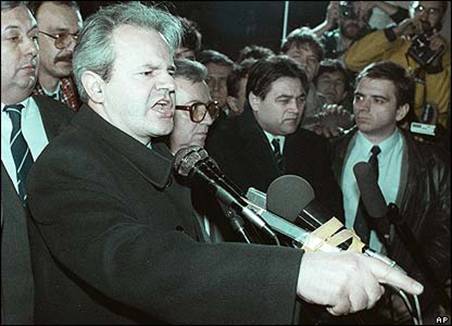
Slobodan Milosevic officially became Serbian president in 1989, in elections widely
regarded as rigged. He abolished Kosovo's autonomy the same year.
An article by Dr. Ichak Adizes
Published in 1999
In July 1991, Mr. Zelenovic, the Prime Minister of Serbia at the time, invited me for consultations on the breakdown of the Yugoslav Federation. I was well known as someone who knew Yugoslavia well. I published two books on Yugoslavia, which were translated to several languages.
When I arrived, I met with a joint session of the cabinet and the leadership in the Parliament of the Socialist party, which was and still is in power. I did an interactive diagnosis of the situation with them.
My conclusion was that the problem was not Slovenia nor Croatia, which were seeking independence (Bosnia was not awaken yet), but that it was Kosovo. It had 2 million Moslems who did not wish to be part of Yugoslavia. With a population plagued by low literacy, high unemployment and high birth rate, the highest in the world with an average of 9 children per family, it was costing Yugoslavia 1.5 billion dollars a year to provide health, education and unemployment benefits.
"How can you keep doing this?" I asked. "While Serbian hospitals have no medicines, you are spending a fortune on Kosovo where people hate you. You yourself say that few years back the Albanians were only 400 000, now they are two million. When will this geometrically expanding wave reach Belgrade? Kosovo is the Serbian gangrene. True, 500 years ago Kosovo was the valley where the Serbian nation was born. OK. I accept your claim that it is the Serbian Jerusalem and one does not give up motherhood's help; but wouldn't you cut your own right arm if it had gangrene or would you let it spread?"
To make a long story short, after a week of debates, Zelenovic thought that I had a point and suggested we go and see Milosevic. It was a meeting of the three of us. No one else. No translators were needed because I speak Serbian fluently, being born there.
To understand what happened next, one has to understand Serb culture. When two people that do not know each other meet, the communication in the beginning is formal, using plural you (Vi). If they seek to become more friendly and intimate, the one with the higher status has to initiate it and the other one has the option to join in. It takes the following form: The higher in status moves to singular you (Ti). If the other person accepts the offered intimacy he moves to use it too. The two will become real friendly and the conversation will become sincere without any "make believes" when the higher in status curses the other person, or better, curses his mother. That is what happened
here. We started with plural you's. I introduced myself. When he heard that I was born in Yugoslavia but raised in Israel he got excited. He considers the Serbs the Jews of the Balkan. "We suffer alike. Everyone wants to annihilate us but we survive in spite of adversity and the bad destiny." He expressed strong desire for Israel and Serbia to renew their diplomatic relations. Then he moved to singular you. I was waiting. The conversation continued and when he said "F'k your mother" I knew we could start talking about Kosovo.
I said: "I understand that Kosovo is the cradle of the Serbian nation. But the Kosovars already said they would win their battle against the Serbs in bed. They are multiplying at a rate you can not ever match. Soon they will be a majority not only in Kosovo but also in Belgrade. It's only a question of time. It is your gangrene."
Milosevic is a very bright person. I have worked intimately with many Prime Ministers and many CEOs of Fortune 100s. You can tell a person whose wheels are turning fast. Milosevic looks at you and you can feel that the guy is intense, a fast thinker and ahead of you.
He turned to Zelenovic and said: "What do you think?" I saw that as an opportunity to dare and say more. "Look Slobo" (I felt I could address him by his nickname after he cursed my mother.) "These 2 million Kosovars are not a fog that one morning we wake up and it is gone. What are you going to do with them? Shoot them all? You can not make them move out of Kosovo either. The world community will not let you do it. They will not allow two million Moslem refugees to be floating somewhere through Europe" Zelenovic agreed with me. "So, what is your suggestion?" Milosevic asked. " I suggest we take advantage of what is dear to the Western society: Self-determination. Let's announce
that we recognize the right of the minorities and different nationalities that comprise Yugoslavia to have self-determination. Let us invite a blue ribbon committee headed by President Carter, who likes these kinds of things, to supervise and observe a national referendum. Those who want to stay in Yugoslavia stay, and those who want to leave, let them separate. The Croats and Slovenes will leave. We lost them anyway. The Serbian in Bosnia will vote to stay and we should do our best to encourage the Kosovars to vote to leave us. The end result will be that we got greater Serbia with no war and we got
rid of the gangrene. It is politically viable in spite of the fact that what brought you to power is the promise to do the opposite: get the Kosovars out and the Serbs in. You can claim that you could not oppose self-determination, which you can make appear through the media which you control as a sacred value. Once the Kosovars are on their own and have to support themselves, they will have to control their reproduction rate. The danger that Albania will join them for a greater Albania is not real because the Albanian leadership
does not want two million Moslems shaking the very delicate balance between the different religions that comprise Albania. They also do not welcome the Kosovo leadership that exhibits an attitude of superiority towards them."
The end of the conversation, which took four hours, was that Zelenovic was given the task of drawing a map of Kosovo. The part called Metohija, where most of the Serbian monasteries are, were supposed to remain in Serbia and the rest was to be let go.
My assignment was to speak with the American ambassador about this deal and get his cooperation. One should not forget that Milosevic himself refused to accept the American ambassador and talk to him. I had a problem now. No one knows me at the State department. I am a nobody there. Who will believe me? Fortunately I had a friend I met through the Young Presidents Organization: Ken Adelman who was the head of the disarmament negotiations for President Reagan and an ambassador to the United Nations. "Ken help," I called him. "Here is what is happening with Milosevic and I need to talk to Ambassador Zimmerman. He does not know me. Make the introductions, please".
The next day when I called the ambassador, I was greeted warmly and when we met I was ushered to a room that appeared secured from electronic eaves dropping. Two young men were sitting there taking notes. I presented what happened the day before with Milosevic. "I do not believe Milosevic," said Zimmerman. "No way” was his conclusion. That is where this initiative died. And come to think Zimmerman might have been right.
I was supposed to meet Milosevic the week after, to deliver Zimmerman's response. I was never asked back.
Poor Zelenovic. He drew maps that Milosevic never asked for. After one week of waiting to see Milosevic I left for South Africa where another assignment was awaiting me. "If anything happens, let me know" I told Zelenovic. The next thing I knew was that Zelenovic got sacked unceremoniously by Milosevic. Insiders in the cabinet, who knew Milosevic intimately, told me that it was because of the affair with me. Zelenovic showed a weakness in his determination on Kosovo.
What Milosevic did was an old Tito trick. "How do you know where the weeds are? You water the garden and wait for them to raise their head. Then you mow them out." That is what Milosevic did. He encouraged me and Zelenovic to tell our true feelings and thoughts. He kept to himself what he really thought and then acted as he thought right. "Uh, I said to myself. This guy is fast and a political genius." And the events thereafter reinforced my judgment.
Milosevic removed all the leadership of the ruling party and put young inexperienced people to lead it. They depended for their political survival on him. Even economically they depended on him. The leaders of the party were people who would starve to death if the party would loose in the elections because they had no profession except being apparatchiks of the party. He had an iron grip on power. After my visit he got Milan Panic, a Serbian immigrant to the United States who even forgot how to speak Serbian and had zero political following to become the Prime Minister of Yugoslavia.
"This whole visit, it occurred to me was a 'job interview'. They were looking for an unknown, but still legitimate face, for Prime Minister and I had blown my opportunity (Thanks God)". That was 1991.
Years passed by and I wondered all these years how in the world was Milosevic going to deal with Kosovo. I have been writing, warning the world about the forthcoming calamity in Kosovo. I had a personal reason to worry too. I was saved by Albanian Moslems during World War II. I felt I had a debt of honor to pay.
Watching the bombing of Yugoslavia on TV, listening to interviews with strategic decision makers like Sandy Berger, the National Security Advisor to President Clinton, I finally realized the morbid genius of Milosevic. Yes!!! He is going to expel the Kosovars out of Kosovo. The two million of them, and he is going to do it with the full cooperation of NATO. How? NATO is in the air only, right? He has a free hand on the ground. Few atrocities will do the trick. A massive exodus will follow. True that in the meantime he will be loosing some airports and several factories because of the raids. He might also loose a few thousand soldiers and civilians but he will clean up the Serbian cradle, something he promised to do when he climbed to power. He will be remembered in the annals of Serbian history as the great liberator. And he can do it under the cover of war. These are war refugees and he is doing it without impunity. How can NATO stop him now? Do more bombing? Of whom? Civilian targets? Bomb Belgrade? It is fine with Milosevic. It will make him an even bigger hero of his nation. He will become the true martyr. Will the Serb people rise against him when the destruction becomes overwhelming? No! It can not be worse than what they experienced in Second World War where every ninth Yugoslav was killed. This nation is used to hardship. They have had a five hundred year long hardship boot camp under the Turks. They will eat grass and leaves and not yield once attacked. Americans yield once they see body bags. Serbs, when hurt, call for revenge and get more hostile, not less. They have been under Turkish influence for a long time. Turks never retreat. Americans think rationally. Serbs think first with their emotions, than they
subordinate their logic to it and if there is no logic, they make it up to fit what they emotionally have decided to do.
Milosevic has played his cards very smart and the West made all the wrong moves. He will clean up Kosovo and the West will end up silently thanking him for it because he removed the Moslem threat of a new Moslem state in Europe. Will they take him to Hague after the war and charge him with crimes against humanity? I doubt it because so far this guy has been more intelligent that any of his counterpart.
- Bookmark :
- Digg
- del.icio.us
- Stumbleupon
- Redit it
What makes a person attractive?
- Posted by - (1) Comment
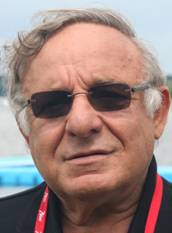
Dr. Ichak Adizes
A blog by Dr. Ichak Adizes
If you ask a man what makes a person attractive, you will get different answers than if you ask a woman.
Men, as I understand, usually focus on physical attributes: the legs, the breasts, etc.
Women tend to focus on the brain and on a man’s ability to support and defend, etc.
I have another idea, which I hope both sexes can agree to. (And if you predict that it has something to do with integration, you’re right.)
When a person has it “all together”––i.e., is integrated––none of their energy is wasted. This person exudes energy, while a person who is “falling apart” takes energy from the people around him or her.
Who is attractive? Those that give you, not take from you, energy.
People who “have it together” are attractive. Those that are “falling apart “ are not.
Years ago, I hired as my assistant a young woman I felt was rather plain and unattractive. On purpose. I assumed that attractive women would distract me from work.
We started working together, and over time I found her to be smart, intelligent, easily receiving and granting respect and trust. I frequently sought her opinion, and respected it: I found her opinions very valuable. I learned a lot. And I trusted her word. If she said something would be done, it was done.
Over time, I stopped noticing her crooked nose or protruding chin. I now thought she was beautiful, and I was hopelessly attracted to her. Unfortunately for me, she was in a committed relationship.
On the other hand, I remember dating a woman who was knockout gorgeous. She had a perfect figure, a face that was hypnotically lovely. She was also well educated and came from a respected family. But I lost interest in her within weeks. My endless enthusiasm ended up in endless disappointment.
What happened?
She had no self-trust or self-respect. She sure was not “together”. And because of that, I believe, she had no trust and respect for others––in this case, for me.
She could not make a decision on her own, and acted totally dependent on me. But when I did make a decision, she did not trust that decision. We had endless debates about what to do and who was right.
This kind of person, often called a “high maintenance person,” has no self-respect and no self-trust. She is not “together,” not integrated. As a result, a lot of her energy is wasted between her ears. She usually looks tired––emotionally tired, not necessarily physically tired. She will tell you in a debate: “Never mind,” or “Fine”––but I came to learn that this only meant the debate was being postponed, not actually resolved.
Although such people can be physically stunning, they often become unattractive to the people they are with––despite being intelligent, highly educated, powerful, and successful.
Being attractive depends on the flow of personal energy, which is a function of physical, emotional, and spiritual integration––in other words, being healthy in body, mind, and spirit.
Now, a personal hypothesis:
It appears that humor needs energy; to be funny requires creativity that consumes energy. Thus, it appears to me that people with a healthy sense of humor are more attractive than those who have none.
My experience is that if you can make a woman genuinely laugh, she will find you attractive. The same goes for men.
What do you think?
Sincerely,
Dr. Ichak Kalderon Adizes
25 Responses to “What Makes a Person Attractive?”
1. Ravi Muddha says:
Dear Sir,
I have gone through the article and respect your perception and personal experiences. Yes, I agree with you that integrity plays a major role in not only building relationships but also maintaining and continuing them for a longer time.
But finally one has look into oneself and integrate with his/her True nature where in we don’t find any differences with the outward world because we become so Self-sufficient and really love ourselves more than any other in this world. Once we can truly love ourselves then we can love anything and anyone in this external world.
Regards,
Ravi
2. KRISHNA says:
Very interesting blog/insight. But I was at a loss to understand how to be more and more integrated as you suggest to be.
3. 123 says:
you have to read the book: men are from mar women are from venus. ![]()
4. 123 says:
it’s not about integration, it’s about same values. You and your first assistant had the same values, that’s why she trusted you. you say that everyone who is integrated trust’s you? and you like everyone who is confident? ![]()
5. Eva Hagi-Niv, Ph.D says:
I read your blog every week and sometimes find it refreshing and educative – like your analysis of ‘a problem’ last week. Thank you. I also agree with your final proposition this time: if you can make the other party laugh – usually and attraction is formed — also (mostly?) because you (the generator) recieve the reaction you seek. Nevertheless,you assume that people crave ‘healthy’ energy. I also would like to assume that, however this is a generalization, both in social and work related relashionship.I have been an organization consultant for 40 years. Mostly in Israel, in all kinds of organizations and communities. I frequently come asross managers that are attracted to ‘yes men’ so that they can feel more powerful, make all the decisions, solve every problem. Unfortunately, the same goes for marital relations as well .
I do not wish to be rude, just honest. If you could add a comment about you basic assumption…
o ichak says:
good point eva. i missed to say attractive physically, sexually.
6. Sebastian M says:
On target!
7. Vlad Burda says:
Ichak, it’s very interesting article. And I really like the way, how you changed your style: From being absolutely sure what you said to in search of truth mode. The last one invite us to discuss! I am also in search and have my own thoughts about the subject.
1.Humour. Women love it. But you must be very careful, not to cross the border to disrespect mode. When you laughing on something including yourself you make the image of yourself bigger then the object of your laugh. You need to keep balance between humour and humility. You do it good in your articles ![]()
2.What men focuse on in women? “the legs, the breasts, etc.”- good, but just if you want receive less then 10% what prepared woman could deliver to you. And if you wrote, that the most important for attractiveness what you could receive from partner not give to him (her) we are approaching to the issue, what you really need from opposite sex in relationships.
I surprised that you nothing said about eyes. The eyes are reflect the deepness of woman and her current state.
What about warmness and charming?
3.The secretary. My experience – male is the best. If she is taking care good about you will be attracted anyway. Doesn’t matter how she looks like. Because care – this is the most important part what we looking for in love relationships. It’s in a certain way substitution of parents care from childhood in a mature mode.
And of course the general thought about being integrated as a whole to be more attractive – is absolutely true!
Whole person has less internal marketing. He (she) has enough, what he(she) needs and ready to give outside.
If you have less internal marketing you could give more to outside client. And our love partner – is the main client in life.
8. guruprasad says:
DEAR ICHAK,
you are absolutely right.You relised it.
Now I la understand wwehy laila and majnu were in deep love. Legend has it that laila was a ugly girl!
I mean physical.It is the energy flow from a person which jells with other which matters that physical beuty attributes.This can be conceptualised !
9. Dion Friedland says:
Dear Ichak, I heard a lecture once from a highly regarded psychologist where he said a sense of humor and the ability to repond with quick responses that made people laugh was a sign of intelligence. Over the years I have found this to be absolutely correct. One of the things that makes people attractive to both sexes is having a sense of humor. It would seem therefore that people are attracted to intelligent people who display their intelligence through humor as opposed to being a “know it all”.
10. Tom says:
I have observed a different phenomenon. When looking at the concept of attractiveness across history and across different cultures we find different descriptions of beauty. For example mona lisa would be considered “fat” today. Many societies consider tanned skin ugly and fair skin beautiful, while in the west we have the opposite perception. Thus I postulate that beauty is more in the eye of the “publisher” than it is in the eye of the beholder. The publishers are the opinion leaders, those that set the standard for beauty in what they place in the public eye. As we are all conformist by nature we conform to this perception of beauty, which is really just fashion. So if “beauty” is as subjective as fashion what then is at the core of attractiveness. If you analyze the different perceptions of beauty across cultures and time you will find 2 common denominators. Wealth and health. (included in health is symmetry) In our culture dark skin means you have time to lay by the pool (wealth). In other cultures light skin means you do not need to work in the fields (wealth)….
11. Kyle says:
Thanks for your ideas and insights.
12. Dion Friedland says:
Ichak, I would like to add that it goes without saying that people who have a positive outlook and are enthusiastic are more attractive to others than those who exude negative energy. People with positive attitudes are generally also higher achievers. This too makes them attractive to others. Having grandchildren, I realize one of the essential things to impress on school leavers is the importance of being positive and enthusiastic about whatever they do and to ensure this positive attitude comes out in the way they speak and smile.
13. Joe White says:
Perhaps, then, Love is for giving. We must first fall in love with ourselves then give that love to others……..if not we will be just taking love energy from others.
14. Citizen John says:
Oh yes. I feel you are correct Dr. Adizes. I go with everything you said except one thing. I think it would take more than weeks to lose interest in the physically attractive but negative-energy woman, under most circumstances. It would surely happen though. Yes, I agree with you.
15. Dragan says:
Number of comments shows how atractive topic this is. Everibody are curious in learning how to be of find atracted/ion.
I would add: there has to be right setup before. If U would not need new secretary… etc etc. Or. how come that you get atracted with person totaly “non-integrated” and it takes few days/week/more to found it out.
BR
Dragan
16. Marko Kiauta says:
Integration means, that “input” was absorbed in what was already there – inside. There is time needed to integrate. If we deal with changes, if we are open for new, it is normaly, that the level of our integration wary. When we go out of box, we at first by definition could not be totaly integrated. But if, we take time to arrange “new”, we will be integrated again.
I believe, that this oscillation is present in every person folowing changes and on the way of growth.
The absence of desintegration can be also a sign of absence of digestion. Everything gous in and out. There is no problem of integration. Person lives on surface!
Thank you Ichak, and all the best to you and all readers
Marko
17. Andrey says:
Dr. Adizes, I agree that integrity makes people attractive, because they are whole, balanced and full of positive energy. Such people Give others all they want without any tention and expectation to receive something back.
On the other hand, disintegrated people need a positive energy from others and use any manipulation to get it. Like a black whole in galaxy. I guess disintegrated people wear a mask and lie. Even themselves. It takes a lot of energy. It based on dismatched values they are declared and real ones. But! They can be attractive as well. Actually, for a very short time. And other people are empty and even seek after communication with them.
18. Branimir Voh says:
Different people are attracted by different things. Why?
Psychology would explain that we are attracted by things which we do not have ourselves.
Philosophy would say that attraction is in the eyes of the seer and not in the object itself.
Both means that we are those who give value that something (or somebody) is attractive or unattractive.
I prefer naturalness instead of attractiveness. Natural attractiveness would be the best.
Attraction is not bad if we are attracted by the right things.
How to avoid unwanted attractions is a relative question.
Actually, do we really want to get rid of them and take the responsibility for ourselves? Or do we prefer to blame the source outside us? It is not easy to stop eating the cake.
Aff.ly,
Branimir
19. Sergii Bystrin says:
Ironically, the more integrated and whole the person become the less he or she will care about outer attractiveness. Energy flow – yes, not sure about personal.
20. Tom Delmonte says:
Very intiguing and I think one that is germane to a significant number of human activities.
I agree the humor plays a significant part in what makes someone attractive because it requires a very good understanding and ease within the context in which a person lives in.
By context I mean understanding the culture, people involved and ease with the subject at hand; In order to make a comment that adds value (smart, clean humor is of value) and at the same time addresses the issue at hand, requires a dexterity of thought that demonstrates a significant amount of skill, and being skilled is something that we all aspire to.
Thanks for the insight.
21. Igor Mironyuk says:
This is absolutely true. Especially i like – when you make somebody sincerely laugh, this person finds you attractive. To me (i am a man) – women’s sincere laugh and smile is the most erotic thing ever.
22. Reuben Ashton says:
Interesting… and again Adizes is wrong, maybe because he thinks American. Americans see women as body parts summing up a body; no wonder silicon dominates the American female body: big tits and the like.
Adizes is missing the whole point of sensuality, that certainly has to do with the female & male bodies, but not as parts and not in that togetherness that is proposed. Sexual attraction is something more sophisticated than the simplistic approach that is being proposed.
23. George Hathaway says:
Your reductionist approach did get a solution, but there is no assurance it is creative or optimal, nor that it has an effective implementation plan. You, of all people, ought to learn about Smart Questions by Nadler and Chandon (Jossey-Bass, 2004). It is the latest iteration of the Breakthrough Thinking methods made popular in the 1990s with the best selling Breakthrough Thinking (Prima Publishing, 1994) and with Creative Solution Finding (Prima Publishing, 1998), both by Nadler and Hibino. All the books contain supporting information about the research that shows the most creative and effective planners, designers, continuous changers, and problem solvers use a different approach than your reductionism.
24. Rajesh Kothari says:
To make this topic more general, I would put it thus.
Why do we find that we are able to get along with them well i.e, we find them attractive; and with some we, for no apparent reason, feel a kind of mild or strong repulsion; and for some people neither attraction/nor repulsion?
Such experiences are easily and properly explained by ‘Karma Theory’ of Hindus. In short, it says that soul is eternal and takes various life forms to undergo effects of its ‘Karma’ (bonds). These bonds are created due to thoughts/deeds/actions when a soul is in a human form.
In any life form, coming together of two or more souls together is never an accident. They come together to undergo effects of bonds. If one has got some good bonds left to be undergone with the other soul then they feel attracted. If they have some bad bonds to be finished (left to be undergone) then they feel repulsion. (Note: This paragraph covers explanation on topic started by Dr Adizes. I would stop here, as this theory requires one more paragraph to explain how to solve life’s problem once and for all.)
- Bookmark :
- Digg
- del.icio.us
- Stumbleupon
- Redit it
- Posted by - (5) Comment
![]()
(means “let’s be together”)
“I challenge all of us to volunteer”
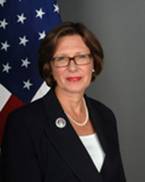 |
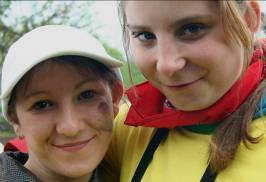 |
Ambassador Anne E. Derse: “The U.S. Embassy is honoured
to be the patron of “Būkime kartu” this year.
On Saturday 28th of May over 100 children from local orphanages will participate in “Būkime kartu 2011”, organized by the international community in Lithuania, including U.S. and other foreign embassies, Lithuanian public institutions and volunteers. The programme is intended to provide the children needed personal attention and care, and to promote the virtues of volunteering in Lithuania.
This event involves more than 150 volunteers from foreign embassies, private companies and public institutions and is under the patronage of the U.S. Ambassador to Lithuania, Anne E. Derse. “The U.S. Embassy is honoured to be the patron of “Būkime kartu” this year. 2011 is the “European Year of the Volunteering” in the European Union, and volunteerism is a value that is strongly held in Lithuania. In the United States as well, we have long believed that service to the community and work done for the greater good is part of the foundation of a stable, free and productive society. I challenge all of us to continue exploring ways to volunteer, give back and make a positive contribution to our communities,” said Ambassador Anne E. Derse, the patron of the event.
Mr. Torben Pedersen, Chairman of the “Būkime kartu” Committee under Vilnius International Club said: “2011 is the 9th year that “Būkime kartu” has been organized on the initiative of Vilnius International Club. It’s a full day of fun and learning, not only for orphans, but also for the many volunteers that made the event happen. Volunteering brings a special experience, which tried once gives an impressive understanding and responsibility for caring for each other. This is what drives us to continue with the event year after year”.
As a special recognition for outstanding contribution to support children of Lithuania, Vilnius International Club has introduced a “Volunteer of the Year” award this year, which will be announced at the event.
During the event children will learn how fire engine works, how police and customs dogs are trained, what equipment has army vehicle or crime lab. These and many other questions will be answered by firemen, army officers, policemen, customs officers and by participation in involving games. Participating children will enjoy many outdoor activities and team games such as a bouncy castle, face-painting, parachute game, spider web, hot air balloon lift and more. There will also be a special appearance by players from BC Lietuvos Rytas, who will provide some basketball lessons for children.
Various organizations have generously offered their support to the event, without which the event would not have been possible, including: Vilnius International Club, US Embassy, Swedish embassy, Danish embassy, Norwegian embassy, Turkish embassy, Bulgarian embassy, Deloitte Lietuva, COWI Lietuva, Rimi Lietuva, Tarptautinė Teisės ir Verslo Aukštoji Mokykla (TTVAM), Viva Green Resort, Ūkio Bankas, Policijos departamentas prie VRM, Vilniaus apskrities vyriausiasis policijos komisariatas (Vilnius County Police Headquarters), Lietuvos Respublikos muitinė (Customs of the Republic of Lithuania), Priešgaisrinės apsaugos ir gelbėjimo departamentas prie VRM (Fire and Rescue department) , Lietuvos kariuomenė (Lithuanian Army), Medicina Magna, Multidora, Pentland, Radisson Blu Astoria, Radisson Blu Lietuva, DnB Nord, Oreivystės centras, McDonald’s, Rokiškio sūris, Antakalnio vidurinė mokykla, Lietuvos socialinės gerovės asociacija (LSGA), BRB Consulting Development, IC Baltic and BC Lietuvos Rytas.
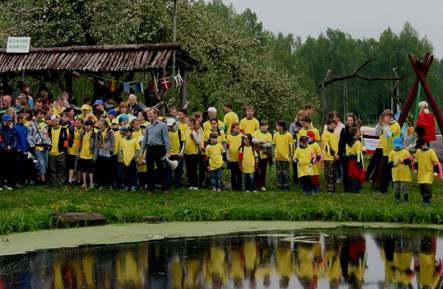
From “Būkime kartu 2010”
The event will take place in the beautiful Viva Green Resort, located 25 km away from Vilnius in Tuščiaulių village, Nemenčinė from 10.00 AM to 4.00 PM on Saturday, May 28th. For a map see http://www.vivagreenresort.lt/kaip_mus_rasti
For more information please contact: Lina Pradkeliene, Phone: +370 5 255 3030, mobile: +370 687 49856 Email: lpradkeliene@deloittece.com
Event program
|
Time |
Activity |
|
10.00-10.15 |
Opening talk |
|
10.15-11.00 |
Face painting |
|
10.20-13.00 |
Police bus, police cars and criminalist laboratory, Fire engine, Army cars, Basketball clinic Team games: castle jump, parachute, elephant feet, cup tower, crazy volley, obstacle course, spider web |
|
11.00-12.30 |
Air balloon lifts |
|
13.00-13.30 |
Police dogs and customs dogs show . Police mate Amsis. |
|
13.30-14.15 |
Lunch |
|
14.15-16.00 |
Police bus, police cars and criminalist laboratory, Fire engine, Army cars, Basketball clinic Team games: castle jump, parachute, elephant feet, cup tower, crazy volley, obstacle course, spider web |
|
16.00 |
Cake, coffee, tea |
|
16.10 |
Closing ceremony |
|
16.20 |
Volunteer of the year Award |
|
16.45 |
End of event |
- Bookmark :
- Digg
- del.icio.us
- Stumbleupon
- Redit it
Look to Norway!
- Posted by - (9) Comment
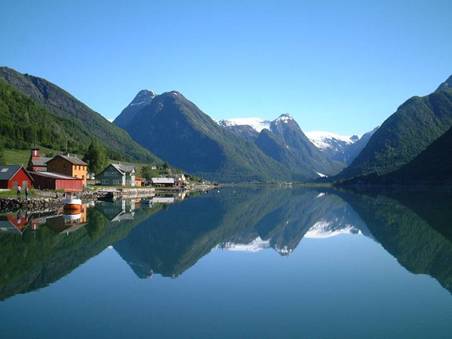
Text: Aage Myhre, Editor-in-Chief
When I came to Lithuania for the first time from my native Norway, more than 20 years ago, this country's political leadership was in the process of drafting the new law book that would be the legal framework for the modern democracy this country was supposed to become after all the years of Soviet occupation. Our small delegation from Norway suggested that one simply could translate our Norwegian legislation, of a free and functioning democracy, but Lithuania's politicians chose not to follow our advice, and used instead many years to develop their own laws. This country's leaders have, for better or worse, an extensive belief in their excellence and ability to reinvent the wheel even when it would have been so much easier to seek advice and help from good neighbours.
Many Norwegian delegations have appeared over the 20 years that have elapsed since that time. They have come and gone without seeing the relationship between Norway and Lithuania thus has become particularly warm or close. In several instances, I know that the Norwegians have travelled back home, headshaking. One example is the delegation that already four years ago came here to give advice on how Lithuania could solve its energy situation after the closure of the Ignalina nuclear power plant. The energy nation Norway was not listened to, and we all know what is now the situation in this country.
But it's not too late to seek cooperation with Norway, in many areas, and I encourage President Dalia Grybauskaite and Prime Minister Kubilius to follow up the visits and meetings that have taken place this last year. Norway is one of the world's richest countries, and also a neighbouring country that in many fields can both understand and help to find solutions to the many challenges still facing Lithuania. I sincerely hope that Lithuania now seizes the opportunity to develop a systematic structure for a very close cooperation with my home country.
The time of emergency measures connected to the crisis and depression areover. Now we need pragmatic, bilateral action.
A good and close cooperation must naturally involve benefits to both parties, and I can imagine many areas where that may be possible. Let me mention a few:
ENERGY
Norway is an energy nation of world format; in oil, hydropower, wind power, solar energy and energy efficiency. Lithuania is in the process of developing their own systems, but could move infinitely faster forward by collaborating with Norwegian companies and institutions.
INDUSTRY
I see it as likely that many Norwegian companies could outsource much of their production to Lithuania. What we need is a skilled professional, who knows Lithuania’s opportunities in manufacturing, who can travel around Norway to discuss possible cooperation projects with Lithuanian companies.
SHIPPING / OFFSHORE
A Norwegian friend of mine produces fittings for ships and oil platforms here in Lithuania. His company has also teams of Lithuanian workers who travel around the world to furnish ships or platforms. An area that could have been expanded to a considerable extent and scope.
AGRICULTURE
In the interwar years Denmark and Lithuania competed to be leaders in northern European agriculture. Today, agriculture in countries like Denmark and Norway at a very high level, whereas Lithuania desperately needs new investment and new technology. A collaboration with Norwegian farmers and agricultural organizations could come to mean endlessly much in this process.
FISHERIES
A Norwegian friend of mine is the director of a fish factory in Klaipeda. The owner is the Bornholm company Espersen. The factory was built new in Klaipeda's Free Economic Zone a few years ago. Now an extension of the factory is underway. This is an excellent example of how Lithuanian labour can do a good job for a company that processes fish for European markets.
TOURISM, COURSES AND CONFERENCES
I am convinced that Lithuania would attract many more Norwegian tourists if they had a person or a group of professional sales people that toured throughout Norway with presentations of what Lithuania has to offer. Not least, this applies to the training and conference sector, which is incredibly large in Norway. Lithuania should clearly be able to come up with very attractive and competitive offers.
Another example: The former Reval Hotels (now operated by Radisson BLU) in Lithuania are Norwegian-owned, and a close collaboration with the owner, the Linstow group, should be investigated further.
SCHOOLS
The Lithuanian school system desperately needs improvement, and collaboration, school-to-school, with Norway, would undoubtedly be useful. I got an excellent example of how useful such cooperation can be when a few years ago I visited the headmaster at the Birštonas Secondary School, Alvydas Urbanavičius. This school, having 800 students, is famous throughout Lithuania for its high level of education. When I asked the headmaster about the reason for this his reply was cards and cash, "We were very lucky to be 'adopted' by a Danish school already in the early 1990s, and the Danes taught us how to run a modern school and also gave us important funding so that we could avoid many of the problems that other Lithuanian schools and the very educational system here is still fighting with."
In terms of higher education, Norway is otherwise heavily involved in Lithuania already. The ISM Universities (University of Management and Economics) in Kaunas and Vilnius, for example, are owned by Norwegian BI (Norwegian School of Management).
But there is much that can be further developed in many levels and learning areas.
HEALTH CARE
A very large number of Lithuanian physicians and other health professionals are today working in Norway. Maybe there could be an idea if one instead tried to find forms of cooperation between Norwegian and Lithuanian health care so that this country would not be completely drained for health professionals for the benefit of rich Norway? Norway has a very important task to fulfil in this aspect, and it should be imposed on Norwegian health policy makers to take this issue far more seriously.
CULTURE, SOCIETY
Lithuania has a wonderful culture that should be experienced by a large number of Norwegians. An extensive cooperation between the cultural sectors of our two countries would mean microns for both parties. As an architect, there is much on my heart to find help to preserve the great Lithuanian wooden houses and other old architecture, and I hope the right institutions in Norway would be ready to help…
During my visit to Lithuania in January 1991, while the Soviet troops surrounded the Parliament and the TV tower in Vilnius, our Norwegian delegation brought with us a letter from Oslo's mayor confirming that Oslo was ready to be Vilnius' first sister city in the west. Later, many Lithuanian and Norwegian cities, municipalities and counties have established friendship agreements. But in most cases only with words, little action.
Now is the time for action. President Grybauskaite’s state visit a few weeks ago is a good step forward, and I hope PM Kubilius and his government now realise that Norway is a land of opportunity – also as Lithuania's closest friend and ally. A comprehensive and professionally planned cooperation structure on many levels should be prepared.
We have no time to lose.
- Bookmark :
- Digg
- del.icio.us
- Stumbleupon
- Redit it
17 May is Norway’s National Day
- Posted by - (3) Comment
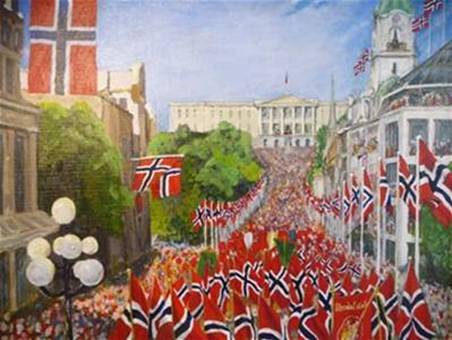
17 May celebration at Karl Johan’s street in Oslo.
The Royal Palace in the background.
The Norwegian Constitution Day is the National Day of Norway and is an official national holiday each year. Among Norwegians, the day is referred to simply as syttende mai (meaning May Seventeenth), Nasjonaldagen (The National Day) or Grunnlovsdagen(Constitution Day), although the latter is less frequent.
The Constitution of Norway was signed at Eidsvoll (a small town 60 km north of Oslo) the 17th of May 1814. The constitution declared Norway to be an independent nation.
The celebration of this day began spontaneously among students and others from early on. However, Norway was at that time under Swedish rule (1814 - 1905) and for some years the King of Sweden was reluctant to allow the celebrations. For a couple of years in the 1820s, king Carl Johan actually forbade it, as he thought the celebrations a kind of protest and disregard —even revolt— against Swedish sovereignty. The king's attitude changed slightly after the Battle of the Square in 1829, an incident which resulted in such a commotion that the King had to allow it. It was, however, not until 1833, that anyone ventured to hold a public address on behalf of the day.
After 1864, the day became more established, and the first children's promenade was launched in Christiania (today’s Oslo), in a parade consisting only of boys. It was only in 1899 that girls were allowed to join in the parade for the first time.
By historical coincidence, the Second World War ended in Norway just nine days before that year's Constitution Day, on May 8, 1945, when the occupying German forces surrendered. Even if The Liberation Day is an official flag day in Norway, the day is not an official holiday and is not broadly celebrated. Instead a new and broader meaning has been added to the celebration of Norwegian Constitution Day on May 17.
The day focused originally on the Norwegian constitution, but after 1905, the focus has been directed also towards the royal family.
A noteworthy aspect of the Norwegian Constitution Day is its very non-military nature. All over Norway, children's parades with an abundance of flags form the central elements of the celebration. Each elementary school district arranges its own parade with marching bands between schools. The parade takes the children through the community, often making stops at homes of senior citizens, war memorials, etc. The longest parade is in Oslo, where some 100,000 people travel to the city centre to participate in the main festivities.
- Bookmark :
- Digg
- del.icio.us
- Stumbleupon
- Redit it
- Posted by - (0) Comment
President Dalia Grybauskaitė on state visit to Norway:
The vast opportunities for cooperation must be used
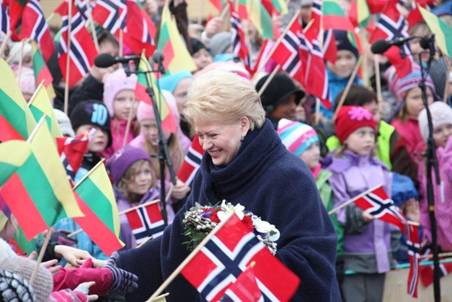
At the second day of her two-day state visit to Norway in early April this year, President Dalia Grybauskaitė was accompanied by King Harald V on a visit to the Fiskerstrand Shipyard in the city of Ålesund in Western Norway.
"This first state visit to Norway has revealed plenty of perfect but unused opportunities for cooperation with the Nordic countries, both in politics and in developing concrete business projects. Joint projects between shipbuilders of Ålesund and Klaipėda in constructing the most advanced ferryboats and between textile producers of the Sula Municipality and Panevėžys are just a few examples of successful economic cooperation. Norway's Prime Minister, other highest politicians of the country as well as businesspeople whom I met confirmed Norway's strong intentions to develop cooperation with Lithuania," President Dalia Grybauskaitė said.
Over-100-years-old Fiskerstrand Shipyard focuses on innovations, ship architecture, construction, repairs and testing. This Norwegian company has been cooperating with Klaipėda's Western Shipyard for 11 years already. The Lithuanian and Norwegian partners are currently carrying out a 90-million-euros-worth project of constructing sea-going ice-resistant ferryboats. Moreover, last year the Fiskerstrand Shipyard contracted the Western Shipyard of Klaipėda to build the world's largest gas-powered ferryboat using advanced technologies.

President Dalia Grybauskaite meeting with King Harald V and Queen Sonja of N at the Royal Palace in Oslo
- Bookmark :
- Digg
- del.icio.us
- Stumbleupon
- Redit it
Roosevelt’s ‘Look to Norway’ speech
- Posted by - (1) Comment
|
King Haakon VII of Norway |
US President Franklin D. Roosevelt |
The "Look to Norway" speech by U.S. President Franklin D. Roosevelt was given during the handover ceremony of the Royal Norwegian Navy ship HNoM King Haakon VII at the Washington Navy Yard on 16 September 1942.
In the speech the President said:
"If there is anyone who still wonders why this war is being fought, let him look to Norway. If there is anyone who has any delusions that this war could have been averted, let him look to Norway; and if there is anyone who doubts the democratic will to win, again I say, let him look to Norway."
The speech served as an important source of inspiration to Norwegians fighting the German occupation of Norway and the rest of Europe as well as for the resistance fighters of other small countries during World War II.
The speech also made an impact on Norwegian-Americans and the rest of the American public's opinion on the struggle in Europe. The impression of the Norwegian's situation had been severely damaged by an article by the American reporter, Leland Stowe, who happened to be in Oslo on the day the Germans marched into the city. He witnessed shocked Norwegian civilians standing around watching the Germans march down the parade street Karl Johan’s gate. He interpreted the shock as indifference and acceptance on the part of the Norwegian population and wrote a stinging article in Time and several newspapers which severely damaged the American public's opinion of the Norwegian resistance and therefore their motivation to help Norway and Europe. The speech corrected that impression.
The speech is still referenced and quoted today.
In a speech on 13 April 1940, the President had already praised the Norwegian resistance. Roosevelt's interest in Norway was in part due to the good relations established by the Norwegian Crown Prince and his wife, Princess Martha, and the Norwegian ambassador to the U.S., Wilhelm Thorleif von Munthe af Morgenstierne.
In 2005 the ceremony, including the speech, was re-enacted to mark the centenary of diplomatic relations between Norway and the United States.
- Bookmark :
- Digg
- del.icio.us
- Stumbleupon
- Redit it
Global financial meltdown? Not in Norway
- Posted by - (1) Comment

One European nation escaped the worldwide financial meltdown and recession more or less unaffected. That was Norway, a country which saved its money - rather than spent it - through the boom years. As a result of frugal financial management, Norwegian housing prices and consumption have been on the upswing and interest rates affordable also during the deepest global crisis the latest years. Norway’s fiscal responsibility of its income from enormous oil and gas reserves has allowed the nation to build one of the globe’s largest investment funds.
After large deposits of gas and oil were discovered in the 1970s, Norway didn’t go on a spending spree, and channelled its revenues into a state investment fund (The Government Pension Fund). As of the valuation in June 2007, it was the largest pension fund in Europe and the fourth largest in the world. As of 31 December 2010 its total value is NOK 3,077 billion ($525 billion), holding 1 per cent of global equity markets. With 1.78 per cent of European stocks, it is said to be the largest stock owner in Europe. The government - with very few exceptions - can spend only four percent of those revenues annually.
Beyond its oil and gas revenues, strict banking regulations - tightened after a banking crisis in the early 1990s - shielded Norway from the credit crisis. Norwegian banks made loans wisely and stayed away from exotic investments and financial products over the past decade. “They (the United States) got all the bright guys to make all kinds of fantastic products. Very creative. And it turned out it was maybe not the best solution in the end,” Mr. Amund Utne, a director of Norway’s Finance Ministry, said, with typical Norwegian understatement. “I think Norwegian banks are not as creative. In this situation, it may be good to be somewhat boring.”
Norway also was immune from the housing bubble. According to Bjorn Erik Orskaug of DnB NOR, Norway’s largest bank, “Housing prices are back up. Consumption is up. Banks are lending normally to the household sector and interest rates are staying low.”
- Bookmark :
- Digg
- del.icio.us
- Stumbleupon
- Redit it
I found my family!
- Posted by - (1) Comment

My first meeting with my family in Lithuania
- we had been searching for 90 years
By KR Slade
It's Saturday, 28 May 2005, 6pm, in Lithuania. I've just returned to my room in the capital city, Vilnius, from my nine-hour day-trip to Kaunas, Lithuania's second-largest city. Kaunas had been the capital of the first Republic of Lithuania, during the inter-world-wars period, and is 90+ percent ethnic-Lithuanian -- compared to 60 percent in Vilnius. Lithuania is, now and since 1990, in its ‘third’ republic, again free, after its second -- and fake --‘Lithuanian Soviet Socialist Republic’, when it was occupied and annexed by the Union of Soviet Socialist Republics. Kaunas is called ‘the heart of Lithuania’, especially by the people of Kaunas. Today is a very special day for my family in Lithuania: the fifth anniversary of the death of our family’s Cardinal Vincentas Sladkevicius.
I exited the mini-bus (CDN$5) on ‘Savonariu (i.e., 'Volunteers' -- named for those who fought against the invading Nazis, or Soviets, or Poles) Prospect’ in downtown Kaunas, after the 1.25 hour trip, which is 1.5 hours by any other kind of vehicle. The mini-bus does not leave Vilnius on any ‘Western’ schedule, other than 'when it is full' with its maximum of eight passengers, or sooner if everyone waiting too-long complains. The driver will stop anywhere a passenger wants. There is a debate as to whether this bus service is legal. I was passenger number eight, so we left in one minute.
My Lithuanian language must be getting better, because upon arriving in down-town Kaunas, the bus driver understood where I ultimately wanted to go, and he told me to take a trolley-bus when he dropped me off. I asked a man at a trolley-stop how to get to the cathedral; but it was his 11-year-old son who became very proud (in front of his father and two younger brothers), because it was only he who could help me in English. Since 1990 independence, English replaced Russian that is taught in schools from first grade.
I got off the trolley-bus (CDN$.45) after I saw Laisves (i.e., ‘Freedom’) Street. I remembered being lost on that wide pedestrian-only street on both of my two previous, cold and rainy day-trips in the last year, to Kaunas.
I arrived early enough to while-away an hour on this summer-like day, with a salad and Coca-Cola (total: CDN$5) at a sidewalk café on the pedestrian-only, cobblestone streets of the nearly-empty Old City. The vegetable salad with milky dressing was good; I’m getting used to the standard room-temperature cola. A group of a dozen foreign tourists arrived, quickly gave up trying to understand the Lithuanian-only menu, began yelling into the basement dinning room for a waitress, ordered beers, and seemed surprised when the 20-year-old waitress completely understood their own second-language English.
I arrived fifteen minutes early at the Basilian-style cathedral; it’s only 400 years old, but it appears 1,000 years older because of its style of architecture, reminiscent of the time of St. Basil The Great, a Father and Doctor of the Church, most revered here in Eastern Europe. I entered and watched a child’s baptism ceremony at the front alter while I walked the length of a side aisle to the private chapel-room. Here, in this Gothic-style quiet area of his cathedral, Cardinal Sladkevicius is buried in the floor.
In a few minutes, about three-dozen relatives, and spouses, some with their small children, had gathered. I had never met any of them.
However, I had extensive research information from my previous seventeen months in Lithuania. Fr. Peternal of Vilnius had helped me for the previous eight months. We obtained the help of Fr. Klimas at the church in the village (i.e., Zasliai -- Guronys) where my family had lived for the last 300 years. Irena, Director of the Cardinal Sladkevicius Museum in Kaunas and author of two biographies of the Cardinal, provided documents. Antanas Paulauskas, author of the unpublished family-genealogy manuscript, wrote a letter to family members to introduce me. A couple of English-speaking cousins, one in London and another in Kaunas, had e-mailed me. Cousin Lina and her husband Marius had telephoned me and introduced me to the no-cost Skype computer telephony so that we could have several more long-distance conversations; and most importantly to tell me that the family’s private commemoration was on Saturday, not on Sunday (that was the public commemoration). Otherwise, I would have arrived a day late, and never met the family. However, I was slightly uncomfortable because some of the family knew me, but I did not know any of them.
In the chapel of this cathedral, after some time for reflection by our family, the very pleasant and jovial Prelate Vincentas Jalinskas entered, summoned us to him to stand around the Cardinal’s tomb, and he sang a cappella some hymns, interspersed with his personal recollections of the Cardinal, whom he knew well, and then greeted every one of us individually. The Prelate walked to the opened door, shook the hand of each of us, and told each of us, in Lithuanian, “Be careful of this step-down, here” as we re-entered the main part of the cathedral where a wedding was now taking place. If not only from the mid-day sunlight streaming blazingly through the ancient windows, perhaps more from exiting our transcendental experience, his caution was to be appreciated, as he well-knew that we all now were walking-on-air.
We all gathered in front of the cathedral for a few minutes, and then about thirty family members drove a short distance to a tiny chapel in a nearby neighbourhood for Mass, with two priests and two folk musicians. Father Alfonsas Bulota was the personal secretary to the Cardinal, and Fr. Virginijus Lenktaitis also knew His Eminence well. After the mass, we walked through the garden behind the chapel to a sit-down lunch gathering at the priest's house, where individuals shared their reminiscences about their uncle/cousin/friend, whom everyone calls 'His Eminence'. I did not understand what anyone was saying, but I could easily understand the fondness of their memories and their profound respect and admiration for our cardinal. The earlier sombre faces of the men and the tears of the women, at the cathedral and the mass, now turned to smiles and laughter.
Janina (the daughter of a brother of the Cardinal), who cared for His Eminence during his last three years’ battle with two cancers, and who took care of me throughout this day (although she doesn't speak any English!) arranged a ride for me back to Vilnius, with two non-English-speaking relatives. Five minutes into the drive, we discovered that Dr. N’s wife, Milda, and I could communicate in French.
Of course, we had to stop for ‘cepelini’, ten minutes out of Kaunas. Cepelini is a favourite Lithuanian ethnic food made from grated potatoes packed around a meatball, usually made of pork, served warm, with a light cheesy sauce. It has a nickname, ‘Zeppelin’ because it is the plate-size oblong shape of a dirigible aircraft. This restaurant is well-known for good ethnic food, and I enjoyed it in the leisurely atmosphere of the garden terrace and watching the children in the playground.
Between our translations of Lithuanian and French, I thought of how I had enjoyed myself so very much this day and how I hoped to have other family gatherings this coming summer. I am fortunate to be related to such nice people; there are twice as many more family members to meet here in Lithuania; there are more in London, the Americas, etc. In addition, there will be my Lithuanian grandmother’s family yet to discover.
One day meeting some of my family, a first meeting since my grandparents left Lithuania ninety years ago; total cost: CDN$10.45; total satisfaction: yes.
A few weeks later, I would find myself in a small village, 20 km from Kaunas, spending the weekend at Janina’s farm. The 24th of June is St. John’s Day, the biggest holiday in Lithuania, and Janina’s name-day, as well as her birthday. St. John’s Day has been celebrated in Lithuania for a thousand years before Christianity arrived here in the fourteenth century; pagans knew that it’s the shortest night of the year.
I became more acquainted with her son, daughter and husband and their 4 year-old, as well as Fr. Bulota, other family, and some family friends. Remembering names and relationships is going to be a temporary challenge. I remember the name of one of the three dogs, but not the cat; maybe there are no names for the five goats, twenty turkeys, four ducks, two roosters, and whatever number of chickens. The bull in the next pasture does not appear to be especially friendly. I rode a bicycle for the first time in 30 years, but only for 3,000 meters to the village store for ice-cream. I enjoyed the farm’s swimming hole. The food brought back forgotten memories of my grandmother’s cooking; the names of many foods here do not have English translations.

The Cardinal's garden-table, now on a farm
The first of our gatherings was out-of-doors, in the yard, around a weathered table, the Lithuanian variety of a picnic-table, of an ethnic design but not otherwise special. The first night was rainy, we ate inside, and afterwards I was shown some family photos of His Eminence. One photo showed the Cardinal in his garden, in his later years: sitting at the same table. Suddenly that table became to me, as it is to everyone who knows, very special. In addition, the photos are kept in the bookcase wall unit, not so special a piece of furniture, except that from the photos it is evident that this bookcase also was his. Now that soviet-era contemporary-design bookcase acquires a very historic provenance. I learned more about his forced and long ‘internal exile’ under the Soviet Regime, when he had been appointed by Pope John XXIII to be a bishop. There were the facts of his life-long suffering from a childhood disease, caused by poor diet from poverty. And, there were the many stories, from his almost eighty years, of interpretations of what he liked and what he did not especially like, and some of these interpretations are for only us ever to know.
I expect to be returning soon to the village to take advantage of my open invitation there. There are many more family, living and past, to get to know. There are more villages to visit. This story does not seem to be going to have an end any time soon...
- Bookmark :
- Digg
- del.icio.us
- Stumbleupon
- Redit it
Cardinal Vincentas Sladkevicius was my cousin
- Posted by - (0) Comment
by KR Slade
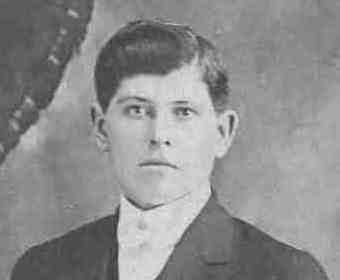
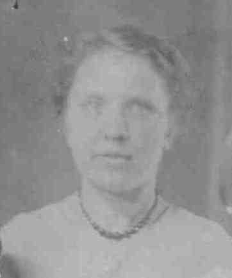
My grandfather Jonas Sladkevicius and grandmother Dominyka Juskeviciute Sladkeviciene
In 1960, my father told me that a member of our family was a bishop in Lithuania. It was there, when part of Czarist Russia, where my grandmother and grandfather had been born sometime in the last decade of the 1800's, from where they emigrated to Rhode Island in the United States where they would meet and marry in 1915. The information about the bishop came from the two Lithuanian-born priests at our Providence, RI church, Saint Casimir’s, where my father attended mass daily since he was a child. Dad also told me, “Don’t tell anybody”. We never again discussed the subject.
The secrecy about things-Lithuanian was already familiar to me by that time, when I was twelve. Details or actual proof of anything about Lithuania was rare. Lithuania was on the other side of the Iron Curtain. Russians (then meaning Communists) could and would make things difficult for those of our family still in the Lithuanian Soviet Socialist Republic, as well as for a missing few of the family presumed to have been sent to Siberia in eastern Russia. Furthermore, didn’t Russian secret agents murder the Lithuanian President early during World War II, when he was in exile in the United States?
Now, fifty years later, I have found, albeit accidentally, the absolute proof that the bishop is my cousin. He was born August 20, 1920, ordained March 25, 1944, named a bishop on November 14, 1957. Sadly, the bishop died on May 28, 2000. Equally sad, my father died in 1981, and would never know that our bishop would become a cardinal.
Bishop Vincentas Sladkevicius was named, in pectore, to the office of a Cardinal of the Roman Catholic Church in 1979 by Pope John Paul II. The Latin phrase is best translated ‘in the breast (heart)’; it means ‘secretly’: not even the bishop knew he was a cardinal until it was publicly announced on June 28, 1988. In fact, most Lithuanians (especially in Lithuania) did not know that Bishop Sladkevicius was a bishop, because upon his consecration the communist government immediately put him into ‘internal exile’, a form of house-arrest, sending him to a remote place in Lithuania (Birstonas village), not allowing him to perform his duties, and with a guard stationed outside his countryside house, which he was not allowed to leave, and where everyone visiting was threateningly examined and harassed.
I found the proof that I was a cousin of the Cardinal after being in Lithuania one year, and one month, one week, and one day. But I had not been looking for proof of my family relationship to the Cardinal; I had been looking for further proof of my Lithuanian descent, so as to obtain state recognition of my Lithuanian citizenship. I came to Lithuania to claim my inherent birth right, by both descent and ethnicity, as a citizen of Lithuania.
In the United States, before leaving for Lithuania, I had obtained about a dozen official documents such as birth, death, and marriage certificates of my parents and my paternal grandparents; and I had further affidavits from the funeral director of my parents, grandmother, and grandfather; all documents gave full and complete testimony as to my Lithuanian descent. These documents were government-certified, with the signatures and seals recognized throughout the United States.
When I arrived in Lithuania, the Ministry of the Interior would not recognize the documents because of a missing and required ‘apostille’. I had practiced as an attorney-at-law for 24 years in the United States and had never heard of an ‘apostille’. (This legal term has no relation to the Christian ‘apostles’, except perhaps for Doubting-Thomas!) It took a few months to determine how to obtain this continuing legal ‘relic from the past’: a further certification as to the authenticity of the US government-issued documents, for use of the documents abroad.
The Lithuanian Ministry of Foreign Affairs was helpful in assisting me in routing the documents to the Lithuanian Consul in New York City to obtain the required ‘apostille’ certification. This delay of many weeks was followed by the Lithuanian requirement of translating the documents into the Lithuanian language, at a considerable financial cost.
Once the documents were in the correct form, then they could be considered by the Migration Department of the Ministry of the Interior. Under Lithuanian law I am a citizen of Lithuania if my great-grandparents were Lithuanian (meaning ethnic origin) or if they were citizens of Lithuania. Therefore, I was not asking to become a Lithuanian citizen, such as by ‘naturalization’, I was asking for the state’s recognition that I was a Lithuanian citizen, by reason of my birth/ancestry.
The Migration Department made an administrative decision that my documents were not sufficient to grant recognition of my citizenship. This decision was made by unknown and unidentified persons, for no given reason(s), and with no right of internal appeal.
The Migration Department therefore sent the ‘not-approved’ application to the Presidential Commission, which has the authority to determine such ‘questionable’ applications. The file reached the Commission a few weeks after the President of Lithuania was impeached and removed from office: on grounds that included wrongfully granting a citizenship through this Commission. Although the Commission has the legal right to meet with applicants, hear witnesses, and take additional evidence, the Commission summarily denied my application. Their official record of consideration of my application consists of one sentence in which they recommend no citizenship. The decision contains no finding of facts, no conclusions of law, and no reasons. The certified decision document states their names, but bears no signature.
This record was ‘secret’; only after my bringing a lawsuit against the Commission would they release their record. They released the record one week after the Court ruled that they ‘had a reason’, and that therefore the decision was proper, even though this ‘reason’ was given to the court after the fact of the Commission’s decision. The Court would not consider my new evidence, because such evidence was obtained after the decision of the Commission.
My new evidence consisted of a certified copy of the report of the Archives of Lithuania showing: my grandfather was born on January 20, 1897 in the village of Guronys (in Zasliai), and baptized on February 9, 1897 in the parish church in the small town of Zasliai. The record shows his parents to be Jonas and Ona. Most importantly, but not so unusual, was the fact that his mother, Ona had the maiden name of Sladkevicius; she and her husband were distant cousins. This fact of the same family name would become very important in identifying family members, where 25 percent of the males were named Jonas (John) and 25 percent of the females were named Ona (Anna/Ann).
When I submitted the official Archive document to the Migration Department they responded with a letter that they cannot consider further applications from me because I have a case against them. After the court case had been decided, in their favour, I resubmitted the evidence. That was 8 November 2004 and it is now more than four months later; I have received no response.

My parents’ wedding, 1947.
On the first of November 2004, I went to the church at Zasliai. All Saint’s Day is the time that Lithuanians gather to remember deceased members of their family. At the graveyard, I found two graves with the name Sladkevicius, but their birth dates were too recent to be my ancestors. I did not know that I was at the wrong graveyard.
In mid-February 2005, I returned to Zasliai with Father Peternal, a Catholic priest from Wyoming who has been in Lithuania for ten years. We met with the parish priest, Father Klimas. When he saw the archive certificate of my grandfather, he showed us a hand-written manuscript of notes and charts detailing the Cardinal’s family history. I took a look at it, but could not make any sense of the document. He told us where to find the farmsteads of the Sladkevicius family, their family graveyard, and the large rock with the new memorial plaque for the Cardinal, where there will be a park to his memory. We wandered around in the snow of Guronys. From the edge of the forest at the hilltop cemetery with the many Sladkevicius graves, we saw a train. That railroad existed before my grandfather was born, and it could have taken a teenage boy (of almost 18 years-of-age) away from conscription into the Czars army for World War I, out of the Lithuania then called Russia, and to a boat to America.
With wet feet, we drove to Lithuania’s second-largest city, Kaunas, for the second half of our excursion. Beside the cathedral, at the Cardinal Sladkevicius Museum, we had an appointment with the director. I was introduced to Irena; she stared at me, took two steps to the side to see my profile, and said, “Of course. Same nose, same mouth, same between. All the Sladkevicius look like that.”
Irena began working for the Cardinal about 10 months before he died. She is a journalist who wrote the first book about him; his reaction was, “Why did you do that?” After his death she wrote a memorial book about his life. The two books are to be edited into one.
In this building the Cardinal lived the last ten years of his life; more than half of which he was ill with cancer. This ‘palace’ is not especially grand. The first floor is under renovation and had been used for administrative offices. The Cardinal’s apartments were on the second floor. There is a very large room used for receptions. There is a chapel for some dozen persons. She showed us the small room that was the Cardinal’s bedroom: a bed, a desk, a chair. Here he died. His death was after many years of suffering. He refused traditional medicine. “I will suffer like Christ on the cross.”
Irena was present when he died. The priest giving the Last Rites said, “Dear God, open Your gates of heaven, and let in Your servant.” That’s when he died. It was a very moving experience to touch his bed and pray there.
Irena showed us a copy of the genealogy manuscript of the Cardinal; this was the updated annex of the original that had been shown to us by Fr. Klimas in Zasliai. She insisted that I borrow it.
After many long hours over several days of examining the 53 pages of the Annex, I began to be able to read the handwriting, to translate the Lithuanian words, to understand the research methodology. The research shows the ancestors of the Cardinal, and it also shows his relatives who are my ancestors. The ‘family tree’ goes back to the early 1700's, almost 100 years before the Czarist Russian Empire annexed Lithuania. It shows the names, birth and death dates, marriages and dates, children and their dates; it also shows which house in the village that they lived. I am a very distant (4th) cousin of the Cardinal through my great-grandfather; but I am also a closer (3rd) cousin through my great-grandmother.
The author of the research report lives here in Vilnius, about 3 miles from me. I wrote a letter to him. He most graciously agreed to meet with me; we have met a second time. He is now obtaining certified documents from the Archives to prove my great-grandparents’ birth/death and Lithuanian descent and citizenship. The documents will be ready in a few weeks. Antanas has written to other members of the family about me. Last week I received the first correspondence from a relative, an e-mail: “We want to socialize with you.”
Spring is coming. Some documents are coming. Antanas volunteered to go with me to Migration to ask about the status of my 8 November re-application, when I will have some new documents in my briefcase. Summer is coming. There will be a time for me to experience the traditional gathering of families. May 28 is the date of Cardinal’s death, and will be a couple of days after the first anniversary of my application for recognition of my Lithuanian citizenship.
- Bookmark :
- Digg
- del.icio.us
- Stumbleupon
- Redit it


Vytautas J. Sliupas at the farm and farm project he founded in 2002,
‘The Auksuciai Farm & Forest Center’ near Siaulia in Northern Lithuania.
After the death of his wife Liudvika, Jonas Sliupas married Grasilda Grauslytė in 1929. After settling in Palanga, their son, Vytautas, was born to them on the 24th of October 1930.
Their son, Vytautas J. Sliupas, later became an irrigation, drainage and water resources engineer. Now retired for many years, he lives in California, USA, but visits Lithuania every summer.
I have the great honour and pleasure to call Vytautas Sliupas my friend. As I understand and feel it, he has the same strong love of Lithuania, which his father had. This despite the fact that he was forced to flee from Lithuania with his parents in 1944 and since has lived virtually all his life in the United States.
Vytautas Sliupas’ farm project in Northern Lithuania
The US non-profit Auksuciai Foundation was established to help small scale Lithuanian farmers become more self-sufficient and competitive in a free market economy. A primary way that Foundation is working to achieve this goal is through support and advisory involvement with a model farm facility (the Auksuciai Farm and Forest Center, a Lithuanian non-profit), that allows participants from academia, business, government, and the farm community to share information and technology regarding environmentally sound management (including forests) and commercial agricultural production practices. Additionally, the Foundation organizes farmer-to-farmer and agricultural student exchanges; farmer mentoring; and in country workshops between the agricultural and forest communities of the U.S. and Lithuania.
The Auksuciai Farm & Forest Center was formally established as a Lithuanian non- profit entity on 9 September 2002.The primary purpose of the centre is to provide Lithuanian farmers with educational and technological opportunities through an aggressive program of local applied research and education. It also serves as a stimulus and facilitator for the incorporation of new technologies in modern agriculture.
The centre is located on a 157-hectare (389-acre) farm near the town of Kursenai in the Siauliai Region in north Lithuania. At this site a year long programme of research on new crops, improvement of existing crops and improved farming practices is conducted by staff. The farm is operated under master lease and use agreement with the Auksuciai Foundation-USA. The operations of the farm are divided into two divisions- Farm Operations and Research and Education programs. Though most of the farming operations are leased out for income purposes it also is used as a large scale demonstration of new and modern farming technologies. The Research and Education division comprises smaller areas of the farm where research on new crops and technologies are conduced under strict scientific procedures. All information generated from the research projects is considered public information and is available at no charge to local farmers and other interested individuals.
One of the latest successful achievements of the farm is the introduction of edible asparagus (smidrai in Lithuanian). Lithuanians long ago knew this very useful vegetable, but during the last century it was forgotten. Now the farm is reintroducing this crop as a very profitable commodity that can be grown by small scale Lithuanian farmers. The farm have plans of greatly expanding this, and other experimental crops, but unfortunately in the last several years the farm’s supporters have decreased considerably due to the world economic crisis, hence Mr. Sliupas and his team are now at the point where they look for new supporters and investors
Aage Myhre
Editor
Mr. Vytautas Sliupas can be reached at sliupasvyt@sbcglobal.net

The Auksuciai Farm & Forest Center
- Bookmark :
- Digg
- del.icio.us
- Stumbleupon
- Redit it
|
|
|
Since the 14th Century two Turkish nationalities – Tatars and Karaims – have been living in Lithuania. From linguistic and ethno genetic points of view they belong to the oldest Turkish tribes - Kipchaks. This ethnonym (Kipchak) for the first time was mentioned in historical chronicles of Central Asia in the 1st millennium BC. Anthropologically ancient Kipchaks were very close to Siberia inhabitants Dinlins, who lived on both sides of the Sajan Mountains in Tuva and the northern part of Gob. In 5th century BC Kipchaks lived in the West of Mongolia, in 3rd century BC they were conquered by Huns. Since the 6 - 8 centuries, when the first nomadic Turkish empires were founded, the Kipchak’s fate is closely connected with the history and migration of the Middle Asia tribes. In Turkish literature they are known as Kipchaks. The history of Karaims is connected with Lithuania since 1397-1398. According to the tradition, The Great Duke of Lithuania Vytautas, after one of the marches to the Golden Horde steppes, had to bring from the Crimea several hundred Karaims and settle them in the Great Duchy of Lithuania. Transference of several hundred Karaim families and several thousand Tatars was not done once. It was in connection with the state policy of The Great Duchy to inhabit the empty areas, build towns and castles and to develop trade and economic life. Initially, Karaims were settled in Trakai between the two castles of The Great Duke, present Karaim Street. Later they were found living in Biržai, Naujamiestis, Pasvalys and Panevėžys. However, Trakai has always been the community's administrative and spiritual centre for Karaims in Lithuania, nowadays more and more also for Karaims throughout the world.
- Bookmark :
- Digg
- del.icio.us
- Stumbleupon
- Redit it
The exceptional relationship between Italy and Lithuania, which was especially evident for the period of 1300 – 1800, will never come back, but will always remain as a remarkable memory, and leave its unique hallmarks in and on Lithuania forever.


It is a myth that Rome and Vilnius both were established by wolves. But it is no myth that the Italians have put an
indelible mark on Lithuania, and when Gediminas, the Grand Duke of Lithuania, in 1323 decided to put down
roots in what is now Vilnius city, a Franciscan monastery was already in place – at the foot of Castle Hill where the Cathedral today is located. Since then, for hundreds of years, the spirit of Rome and Italy played a main role in the development of Vilnius and to a certain degree also of Lithuania.
No wonder that Vilnius sometimes is referred to as “the world’s most Italian city outside Italy”.
1300 – 1400:
The Grand Duke writes to the Pope
* Italy was involved in and with Vilnius already from its very first days as a capital city. Even the name Vilnius was used for the first time when Grand Duke Gediminas in 1323 – the same year he founded the city - wrote to Pope John XXII asking for support in Christianizing the Grand Duchy of Lithuania, by then one of Europe’s leading nations.


Grand Duke Gediminas and Pope John XXII
* Gediminas invited merchants, craftsmen, bankers, farmers, and soldiers to come to the new capital, guaranteeing all freedom of beliefs and good working conditions. Vilnius became thereafter truly international, though not with much of German or Scandinavian influence, as one could expect, rather influenced by Rome – greatly different from the other two Baltic capitals.
* Early examples of Italian influence within architecture, where at least some fragments of heavy, massive walls and other elements, typical for the early Gothic period, still do exist in some Vilnius churches, among them the Cathedral, the Church of Assumption (Traku 9) and the Church of Resurrection (Didzioji 17).
* And, there is one church you really should visit if you would like to smell the 700 years of Italian influence on Lithuanian history. That is the St. Nicholas Church (Sv. Mikalojaus 4). This tiny little church was originally erected around 1320, and remains the oldest Gothic building in town, though with several changes over the centuries. But a true beauty!

St. Nicholas Church, Vilnius
1400 – 1500:
Prince Casimir, Patron Saint of Lithuania, educated by Italians
* Young Prince Casimir (1458 – 1484) was supposed to be a Grand Duke, and also to ascend the throne of Hungary, but chose a spiritual life instead. He died of tuberculosis at an age of 25, and his remains (today resting in the Vilnius Cathedral) quickly won fame for miracles, so already in 1521, Casimir was elevated to sainthood, and canonized by Pope Leo X. He is considered the patron saint of Lithuania and Poland. The cult of St. Casimir has left a deep mark in the history and art of Lithuania. And, of course, one of Casimir’s main teachers was Italian, the humanist Callimachus Buonacorsi, who described Casimir as a “holy youth”, and also wrote; “He should either never have been born or should have abided with us forever”.
* This was also the century when, according to the Polish historian Jan Dlugos, the legends about Lithuanian’s similarities with the ancient Romans arose – also stating that the name Lithuania derived from “l’Italia.”
* By the end of the 14th Century, the fusion of Italian and Northern European art had lead to the development of an International Gothic Style (the first Gothic style originated already around 1150, at the fall of the Roman Empire). Leading architects and artists travelled all over Europe, and also Lithuania got its part of this new Gothic wave by the end of the 15th Century, today first of all symbolized by the probably most famous structure in Vilnius, the Church of St. Anne (below) – a masterpiece nearly unsurpassed in the world - and the connected Church of St. Francis and St. Bernadine – built by Bernadine monks who arrived in Vilnius by the middle of the century.

St. Anne Church, Vilnius
1500 – 1600:
Vilnius becomes a Renaissance capital, competing with Florence
* Throughout the Renaissance, when Italy was a trading centre and a melting pot for the world’s greatest civilisations, Vilnius also became a Renaissance centre, competing with Florence and Milan. The two great nations merged when Grand Duke Sigismund the Old (1467-1548) married the Princess of the Italian cities Bari and Milan, Bona Sforza, and returned to reign in and from Vilnius as the capital of the Grand Duchy of Lithuania. They created an Italian community within the court and, under the influence of the new Grand Duchess, Italian culture became the preoccupation of the city’s elite; macheroni, skryliai, and even the confection marcipanus became staples among the cogniscenti; and life at court became a series of cultural events, with rich noblemen competing for extravagance.
* During the rule of Sigismund the Old The Royal Palace in Vilnius was greatly expanded, to meet the new needs of the Grand Duke – a new wing was added, as well as a third floor; the gardens were also extended. The palace reconstruction plan was probably prepared by Italian architect Bartolomeo Berrecci d Pontassieve, who also designed several projects in the Kingdom of Poland.
It was in his Vilnius palace that Sigismund the Old welcomed an emissary from the Holy Roman Empire, who came to introduce Sigismund to Bona Sforza, his second wife, in 1517.
* The education of the royal couple’s son, the later Grand Duke Sigismund August (1520-1572), was the responsibility of a Sicilian, Jonas Silvijus Amatas, between 1529 and 1537. Sigismund Augustus further developed Lithuania’s first library that his mother brought from Italy, and sent scholars and traders across Europe to assemble volumes of practical and historical value. Sigismund Augustus later took an Italian lover, Diana di Kordona. Dates are not available, but it is recorded that even at the age of 40, she had maintained her beauty and charm.
* In 1532, the Vilnius Cathedral Orchestra was performing with the Grand Duchess, Bona Sforza, singing alto!
* Sigismund II Augustus was crowned Grand Duke of Lithuania in the Royal Palace. He carried on with palace development and lived there with his first wife Elisabeth of Austria, daughter of the Emperor of the Holy Roman Empire. She was buried in Vilnius Cathedral. Sigismund II's second wife, Barbara Radvilaite, also lived in the palace. According to contemporary accounts of the Holy See emissary, the Royal Palace at that time contained more treasures than the Vatican. Sigismund II also assembled one of the largest collection of books in Europe. This collection became an important part of the library that opened in Vilnius in 1570, since 1579 known as Vilnius University Library.

The Royal Palace, Vilnius
* Sigismund Augustus rebuilt the Lower Castle and furnished it in a very luxurious, Renaissance style. It was turned into a centre of Renaissance culture, boasting an excellent library, a theatre, a choir, a picture gallery, and a collection of tapestries. The castle, as well as other venues of the city, was open for masquerades and competitions, scholarly disputes and feasts. In Vilnius, the ruler kept horse-stables with two thousand horses and even something like a zoo – five bears, a lion and ten camels. The plan was prepared by several Italian architects, including Giovanni Cini da Siena, Bernardino de Gianotis Zanobi, and others. The palace was visited by Ippolito Aldobrandini, who later became Pope Clement VIII.
* In 1562, Georges Blandrata, a physician from the University of Bologna, was installed as antitrinitoriu teoretiku (roughly, master of theoretical information) at the royal court in Vilnius.
* In 1562, Lithuania got an extremely important, firm transport link to Western Europe and Italy, when the post-route Vilnius-Krakow-Vienna-Venice opened.
* In 1569, the bishop established Vilnius College and School Theatre. A year later, its first performance was a comedy, “Hercule”, by Italian S. Tucci.
* Also in 1569, the first four Jesuits arrived, and in 1570 they founded the Jesuit College of Vilnius. It became Vilnius University in 1579, by decrees of Pope Gregory XIII and Grand Duke Stephen Bathory.
* In 1571, an Italian goldsmith, Petra Petina, was accepted as a designer of coins and medals by the Lithuanian Royal Mint, and his coins and medals produced during the reign of Stephen Bathory are considered the most significant of ancient Lithuanian coins.
* In 1584, Simonas Simonijus, a physician from Padua, conducted the first autopsy and two years later, in 1586, he published the first medical text in Lithuania.
* On the 29th of October 1579, Pope Gregory XII issued a bull acknowledging the Vilnius University, which soon became the major intellectual center of Lithuania and North-East Europe. It is regarded as one of the oldest and most respectable universities in Eastern and Central Europe, including its extensive collection of Latin literature. The University includes twelve courtyards, whereof the Great Courtyard is the most valuable in the historical and artistic respect. It reminds an Italian Renaissance square, though it combines elements of three styles – Renaissance Mannerism, Baroque and Classicism.

Vilnius University and the Church of Sts. Johns’
(the church’s freestanding bell tower to the right)
1600 – 1700:
The Vilnius Silhouette turns Baroque
* During the 17th Century, Vilnius turned more and more Baroque, in fact becoming the largest Baroque city north of the Alps, as well as the one farthest to the east.
* During this period, excellent monuments of Baroque were built, such as the Church of St. Casimir (1604-1618) – designed along the line of the famous Il Gesu Church in Rome, and St. Theresa Church (1633-50) – where the façade was designed by the Italian architect Constantino Tencalla in accordance with the models of Roman architecture. Other outstanding monuments of the Baroque period are the churches of St. Ignatius and All Saints.

The Church of St. Casimir in the centre of Vilnius.
* And do not forget to visit the Chapel of St. Casimir in the Cathedral - one of the most artistic Baroque Mausoleums in all of Europe!
* The most exquisite Baroque monument in Vilnius, however, is the unique Church of St. Peter and St. Paul (1668-1704). Its interior décor, consisting of 2000 stucco statues, is unique in Europe. The Italian sculptors Pietro Perti, Giovanni Maria Gallia and others did the decoration works during a period of 33 years. The church was renovated in 1801-04 by Giovanni Beretti and Nicolas Piano, both from Milan.
* Around 1600, Giovanni Battista became conductor of a castle orchestra and author of many masses and motets still played.
* Along the way, scholars were going south for education, and fashions, fabrics, and music from Italy were shaping the culture of Lithuania.
* It is also really worthwhile going to Kaunas to see one of the most prominent examples of Baroque architecture in Lithuania. Go to the peninsula of the Kauno Marios Water Reservoir. The Pazaislis Church and Monastery (picture below) was started built in 1667, by Italian Camalduli monks, who were invited to Kaunas by the Chancellor of the Grand Duchy of Lithuania, Kristupas Pacas. The most striking part of the ensemble is a hexagonal dome, and two protruding towers, looking like helmets. Several generations of Lithuanian and Italian masters worked at this impressive complex until it was completed by the middle of the 18th century, but the first, and main master, was the Italian architect Lodovico Fredo.

1700 – 1800:
The Italian sculptures on the Vilnius Cathedral
* Classicism was introduced to Lithuania from Rome, where some of the most famous Lithuanian artists, architects and other performers of the fine arts were studying during this century. The famous painter Pranciskus Smuglevicius studied for example at the St. Lucas Academy for a number of years, and the architect Laurynas Gucevicius was in Rome for studies during the period of 1776-1777.
* The first appearance of Neo-Classicism came also from Rome, when the architect Carlo Spampani in 1773 came here to design the portal in the White Hall of the Vilnius University’s Observatory of Astronomy.
* In 1784, the bishop of Vilnius, I. Masalski, invited the famous Italian sculptor, Tommaso Righi, to come here for the creation of sculptures on the Vilnius Cathedral. His creations can today be seen on the western façade, in six niches where he gave life to the four evangelists, with Moses and Abraham on each of the sides.

Vilnius Cathedral
* The Vilnius Cathedral Treasury does also contain several objects with Italian origin, worth a separate study. The treasures were so carefully hidden behind brickwork in one of the Cathedral’s niches just before the World War II, that they were discovered again only in 1985.
* Attention should also be paid to the gorgeously carved High Altar of the St. Francis and Error! Hyperlink reference not valid., created by the Italian Master Danielo Giotto by the end of the 18th century.
* Also gardens and parks were made according to Italian style. The most famous was probably the Gostauto Garden, which today mostly is covered by the Presidency Park. The original garden was made following the example of Northern Italian parks, and was said to have been one of the most beautiful, being laid out geometrically with straight radial paths, round square and regularly shaped lawns characteristic of the baroque age.
* Try also to find time for a weekend trip to southern Latvia to visit the Rundale Palace (1735-1768) near the town Bauska, 200 km north of Vilnius, supposed to be the most beautiful Baroque palace in the Baltic States, created by the author of the St. Petersburg’s Winter Palace, the Italian architect Bartolomeo Rastrelli.

The Rundale Palace
* In 1795, Lithuania lost its sovereignty, and became a province of the Russian Empire. With this, also the extraordinary and long-lasting contact with Italy vanished. The 500 year golden period had come to an end.
1800 – 1900:
St. Peter and St. Paul Church gets its final Italian touch
* The direct Italian influence on and in Lithuania disappeared more or less in the 19th Century. But also the Russian Empire had its influence from neo-styles inherited from Italy, and some examples of these styles can be found in Lithuania.
* One example of direct influence from Italian masters, also in this century, is the renovation works on the St. Peter and St. Paul Church during the years 1801 - 1804 (ref. above description from the period 1600 - 1700).

St. Peter and St. Paul Church interior
* And, do by no means miss the chance to visit Traku Voké to see the magnificent Estate of Count Tiskevicius, built in 1876 - 80 by the Italian architect L. Marconi.

The Traku Voké estate of Count Tiskevicius
1900 – 2011:
Italian pizza, technology and fashion invades Lithuania
* More than 200 years have passed since the golden period of the Italian-Lithuanian relationship ended. Today, the relationship is being re-built, and Italy is once again well represented in Vilnius, with Embassy, Cultural Centre, a Chamber of Commerce and many different companies.
* And, as in the rest of the modern world, the streets of the Lithuanian cities and villages have in the latest years been “invaded” by Italian pizzerias, fashion boutiques and furniture stores.
* The latest 20 years has also brought a good number of Alfa Romeos, Fiats, Lancias, and even a few Ferraris, Maseratis and Lamborghinis to Lithuania.
* The Italian influence on the Lithuanian architecture is no longer very important. But there has been one exception from that; the new Italian embassy building in the district of Zverynas in Vilnius. The former Italian Ambassador to Lithuania, Giulio Prigioni, did a fantastic job during the years 2004 – 2006 in leading the renovation of a 100 year old Palladian villa into a modern building that today is Italy’s very representative headquarter in Lithuania. The renovation project was done by the Italian architect Nunzio Rimmaudo.


Former Italian Ambassador Giulio Prigioni did a tremendous job to remake
this 100-year old Paladian villa into what today is the representative
Italian Embassy complex in Lithuania.
* Lithuania’s Armed Forces spent in 2006 - 2008 €75 million to buy three units of the Italian transport aircraft C-27J. The selection was made within a bid for the renewal of the old fleet of Soviet-made twin-engine An-26s in service with the Lithuanian Air Force. The Italian-Lithuanian relationship is again flying high…

The Italian transport aircraft C-27J is now used by the Lithuanian Armed Forces.
- Bookmark :
- Digg
- del.icio.us
- Stumbleupon
- Redit it
VilNews e-magazine is published in Vilnius, Lithuania. Editor-in-Chief: Mr. Aage Myhre. Inquires to the editors: editor@VilNews.com.
Code of Ethics: See Section 2 – about VilNews. VilNews is not responsible for content on external links/web pages.
HOW TO ADVERTISE IN VILNEWS.
All content is copyrighted © 2011. UAB ‘VilNews’.

 Click on the buttons to open and read each of VilNews' 18 sub-sections
Click on the buttons to open and read each of VilNews' 18 sub-sections 









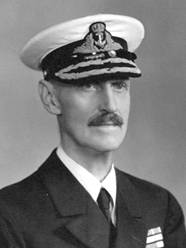
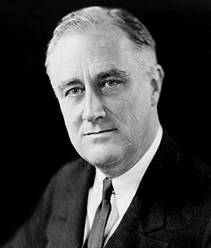
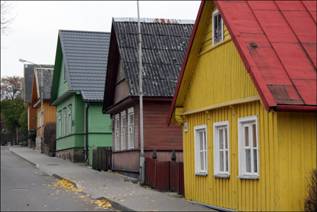
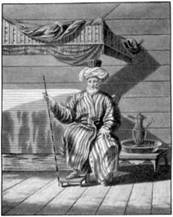
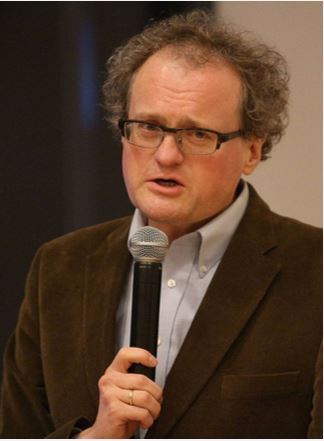
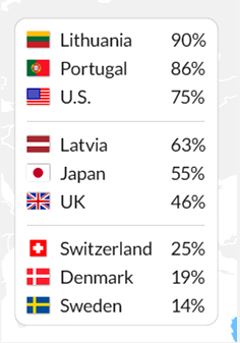
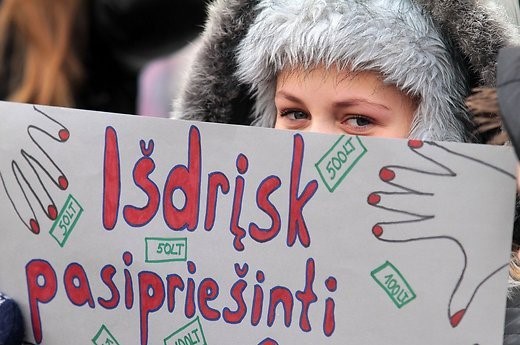


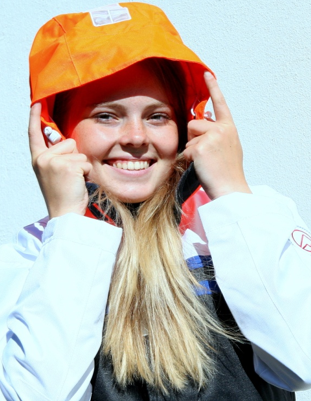
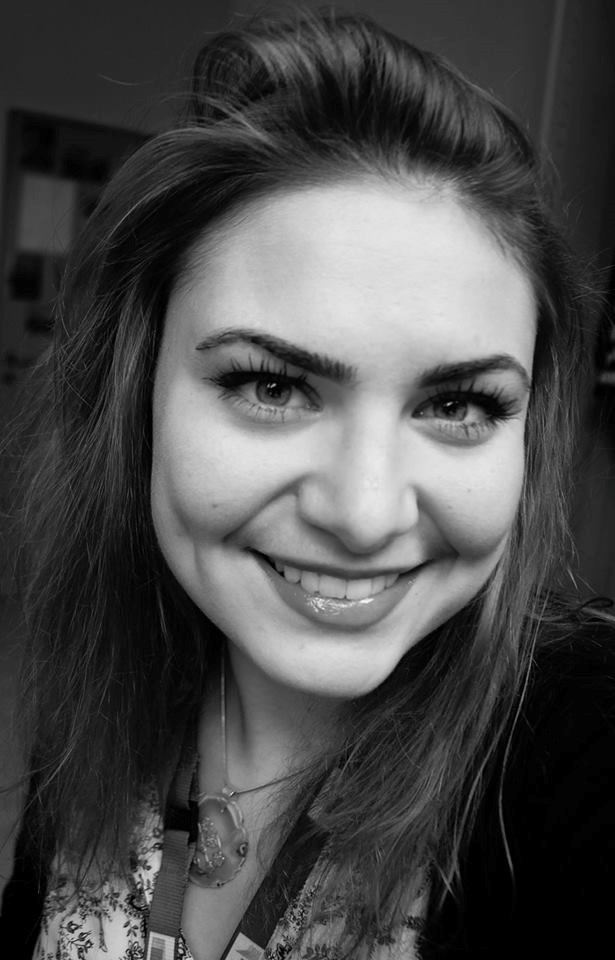
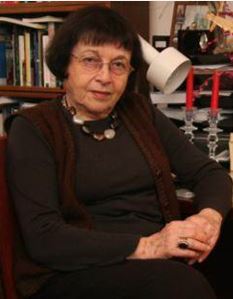
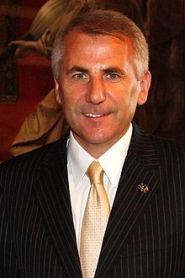
.jpg)
